0 Volumes
No volumes are associated with this topic
Gardens Flowers and Horticulture
Gardening, flowers and the Flower Show are central to the social fabric of Philadelphia.
Fernery
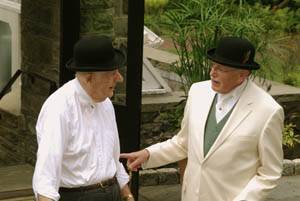
|
| Gardeners |
As explained by the curator of The Morris Arboretum, there are a few other ferneries in the world, but the Morris has the only Victorian fernery still in existence in North America. That doesn't count a few shops that sell ferns and call themselves ferneries; we're talking about the rich man's expensive hobby of collecting rare examples of the fern family in an elaborate structure. That's called a Victorian fernery. The one we have in our neighborhood is really pretty interesting; worth a trip to Chestnut Hill to see it.
Although our fernery was first built by the siblings John and Lydia Morris, it was rebuilt at truly substantial cost by the philanthropist Dorrance Hamilton. It is partly above ground as a sort of greenhouse, and partly below ground, with goldfish and bridges over its pond. Maintaining an even temperature is accomplished by a complicated arrangement of heating pipes. The temperature the gardener chooses affects both the heating bill and the species of fern that will thrive there. You could go for 90 degrees, but practical considerations led to the choice of 58 degrees. The prevailing humidity will affect whether the fern reproduction is sexual or asexual, a source of great excitement in 1840, but survivors of Haight-Asbury are often more complacent on the humidity point.
There are little ferns, big ferns, tree ferns, green ferns, and not-so-green ferns; the known extent of ferns runs to around five hundred species. Not all of them can be found in Chestnut Hill, what with humidity and all, but there are enough to make a very attractive and interesting display. For botanists, this is a must-see exhibit. For the rest of us, it's probably the only one of its kind we will ever see, a jewel in Philadelphia's crown, and shame on you if you pass it by.
Gardening Survives

Adam Levine, the author of a new book about the Philadelphia public garden scene was recently the featured guest speaker at the Franklin Inn. He's a charming person, and has given us a great book.
He draws to our attention that the Philadelphia region is pre-eminent in the garden world, and has been so for several centuries. While it is true that Philadelphia has a mild enough climate to be suitable to two climate zones, the early settlers came from a region of middle England that has been a garden center since Roman times. And they were Quakers, uncomfortable with the outward show in buildings and furnishings, but flowers were innocent instruments of the display. Although Chanticleer was created by a Pennsylvania German family, the great centers of public gardens are mostly traceable to the influence of Quakers, and the du Pont family. Since one or two years of neglect will ruin almost any garden, the essence of great gardens lies in the ability to survive.
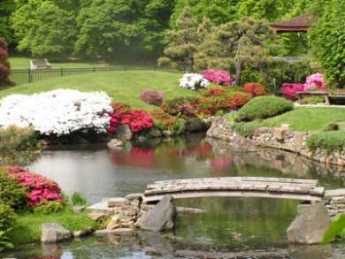
|
| The Horticultural Society |
In fact, the Philadelphia area contains hundreds of gardens which have decayed and virtually disappeared. The Horticultural Society is at the heart of garden preservation, financed in large part by the annual flower show, but even that thriving organization is hard pressed to do justice to the vast areas that need tending. Woodlands would be an example of an area needing tending, and Friends Hospital is an object lesson. When that venerable institution was sold to sharp pencil types from out of town, the Azalea gardens on the grounds were closed to visitors, except for two hours a year. It makes you tremble to imagine how long this famous azalea collection will probably survive. Meanwhile, Germantown's famous gardens are maintained in a minimal way, stretching the resources of the owners who have more urgent demands to meet in their buildings and furniture. Indeed, it is hard to name a really outstanding garden within the city limits, with the exception of the Morris Arboretum, which barely makes it within city boundaries. The area back of the Art Museum along Boathouse Row makes a brave attempt in the spring, but it's a pale reminder of the glory which used to be seen in East Fairmount Park, especially at Lemon Hill, Stenton, and Cliveden. Stotesbury is just a relic.
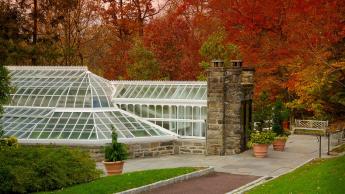
|
| Morris Arboretum |
Gardens have moved to the suburbs. Chanticleer, the Morris Arboretum, Longwood Gardens, Nemours, the Scott Arboretum at Swarthmore, West Laurel Hill, The University of Delaware in Newark, Cabrini College in Villanova, Haverford College Arboretum, Temple University's Ambler campus, and the Trenton Sculpture Gardens on the old fairgrounds -- all would demand mention in any list of outstanding gardens in America. But only a few of them aspire to the standards of an outdoor sculpture garden, where the goal was to surround each piece of sculpture with a garden in such a way that only one sculpture could be seen at a time. Now, that was gardening on the grand scale.
Hidden in a regional garden scene is the seed merchants, starting with John Bartram and famous under the Burpees, which make gardens possible. After all, there has to be a place to find these things. Perhaps the catalog stores, like Wayside Gardens, are the hope for the future. Every shrub or tree transported from a nursery takes up a ball of topsoil along with the specimen, and the appearance of nurseries around the periphery of a city is usually the first step in the development of housing projects. If there is an investment of topsoil in every garden, perhaps we ought to think a little bit about the way we let the investment dry up and blow away.
REFERENCES
| Gardens of Philadelphia and the Delaware Valley William Klein Jr. ISBN-10: 1566393132 | Amazon |
Quaker Gray Turns Quaker Green
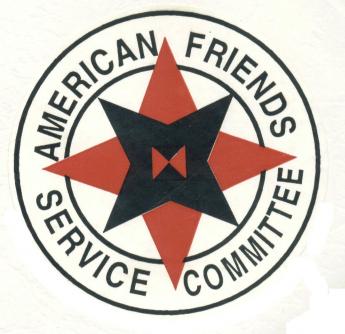
|
| American Friends Service Committee Logo |
Miriam Fisher Schaefer, at one time the Chief Financial Officer of the American Friends Service Committee, had to cope with the economics of renovating the business headquarters complex for various central Quaker organizations. They're housed in a red-brick building complex, naturally, located on North 15th Street right next to the Municipal Services Building of the Philadelphia City Hall complex. The original building within the complex is the Race Street Meetinghouse, funds for which were originally raised by Lucretia Mott. The Quakers needed to expand and renovate their offices, a nine million dollar project. Miriam, a CPA, calculated that the job could be made completely environment-friendly for an extra $3 million. The extra 25% construction cost explains why very few buildings are as energy-efficient as they easily could be. However, in the long run, a "green" building eventually proves to be considerably cheaper. Not only would a green Quaker headquarters be a highly visible "witness" to environmental improvement, but it would also pay for itself in reduced expenses after about eight years. That is, if friends of the environment would provide $3 million in after-tax contributions, they would provide a highly visible example to the world, and reduce the running expenses of the Quaker center by a quarter of a million a year, indefinitely. Effectively, this is a charitable donation with a permanent tax-free investment return of 12%, quite nicely within the Quaker tradition of doing well while doing good.
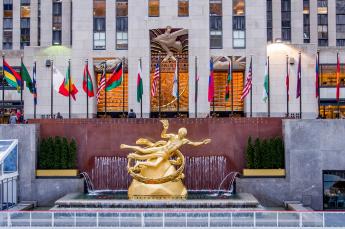
|
| Rockefeller Center |
Energy efficiency isn't one big thing, it is a lot of little things. If you dig a well deep enough, its water will have a temperature of 55 degrees, and only require heating up another 15 degrees to be comfortable in winter, or cooling down thirty degrees to be comfortable in the summer; that's described as a heat pump. Then, if you plant sedum, a hardy desert succulent plant, on the roof it will insulate the building, slow down rainwater runoff, and probably never have to be replaced. Rockefeller Center, you might be interested to learn, has a "green roof" of this sort, which has so far lasted seventy years without replacement. The Race Street Meetinghouse was built in 1854 and has so far had many roof replacements, each of which created a minor financial crisis when the need suddenly arose.
The ecology preservation movement is full of other great ideas for city buildings because buildings --through their heating, ventilating and air conditioning -- contribute more carbon pollution to the atmosphere than cars do. For another example, fifty percent of the contents of landfills originate in dumpsters taking construction trash away from building sites. What mainly stands in the way of more recycling of such trash is the extra expense of sorting out the ingredients. Catching rainwater runoff allows its reuse in toilets, eliminating the need to chlorinate it, meter it, and transport it from the rivers. And so forth; you can expect to hear about this sort of thing with great regularity now that the Quakers have got stirred up. You could save a lot of air conditioning cost by painting your roof white. At first, that would look funny. But do you suppose oddness would bother the Society of Friends for one instant? No, and you can expect them to make it popular, in time. People at first generally hate to look funny, but with the passage of time they grow to like looking intelligent.
A lot of people want to save the planet. So do the Quakers, but they have come to the view that the public is more easily persuaded to save money.
Delaware Bay Before the White Man Came
Captain John Smith of Virginia, sometime friend of Pocahontas, wrote a letter to Captain Henry Hudson that he understood there was a big gap in the continent to the North of the Virginia Capes, and maybe this was the Northwest Passage to China. Hudson set out to look for it.

|
| Hudson |
Smith's misjudgment now seems like a credible story if you take the ferry from Lewes, Delaware to Cape May, New Jersey. You are out of sight of land for half an hour on that trip, and it's a hundred miles of blue salt water to Philadelphia if you decided to go in that direction. In fact, the bay widens out to double the width or more, just inside the capes, and you can see how an explorer in a little sailboat might believe there was clear sailing to the Indies if you went that way. But as a matter of fact, Hudson encountered so much "shoal" that he ran aground repeatedly trying to sail into the bay, and soon gave up. He encountered a swamp, not an ocean passage. The Hudson River, and later Hudson's Bay, seemed like better bets.
What Hudson had encountered was one of the largest gaps in the chain of Atlantic barrier islands, formed by the crumbling of the Allegheny Mountains into the sea, and then washed up as beach islands by the ocean currents. At various points, the low flat sandy islands became re-attached to the mainland as the intervening bay silted up, and that's why the islands of New Jersey and Delaware seem like part of the mainland. And that's what would have happened to the whole Delaware Bay if it hadn't been ditched and dredged, and wave action diverted with jetties. The swamp was a great place to breed insects, so fish were abundant, and that brought birds in vast numbers. Two stories illustrate.
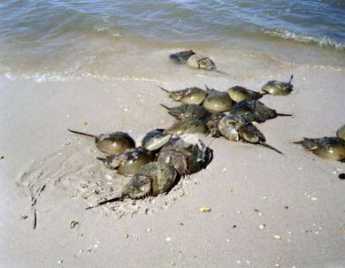
|
| Horseshoe Crabs |
Once a year, a zillion ugly Horseshoe Crabs crawl out of the sea onto the Lewes beaches, and lay a million zillion eggs in the sand. Almost to the moment, a swarm of South American birds swoops out of the skies to eat the eggs. Those birds started flying months earlier from thousands of miles away, but their timing with regard to Delaware crab eggs is perfect, so this evolutionary semi-miracle must have been going on for many centuries.
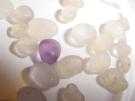
|
| Cape May |
Now, coming from the other direction, every hour each fall it is possible to see a hawk or two flies south to Cape May, then sort of disappearing in the woods. And then, at some unknown signal, tens of thousands of hawks rise from the bushes and travel together on the thirty-mile passage over the bay and then go on South. Cape May has lots of migratory birds and bird watchers, and it also has Cape May "diamonds", which are funny little stones washed up at the tip of Cape May Point.
In the spring, vast schools of successive species of fish migrate up the Delaware Bay to spawn in the reeds along the shoreline, but as each school encounters the point where the salt water turns fresh, they stop dead. They mill around at this point for several weeks adjusting to the change of water and then go on about their business. While they are there, it is possible for amateurs to catch amazing amounts of fish, if you know the best time, and if you know where the salinity changes. Since heavy or light rainfall can shift the salinity barrier fifty miles, you have to own your own boat if you want to enjoy this phenomenon, since the rental boats are all spoken for months in advance. Fishermen don't like to tell you about such things; patients of mine who literally owed me their lives have refused to say where I might find the fish this year.
Over on the New Jersey side of the bay, oysters like to grow, although something has just about wiped them out in recent decades. There is a town called Bivalve, which is worth a visit just to see the towering piles of oyster shells left over from last century. For miles around, the roads are actually paved with ground-up oyster shells. Up north around Salem, the shad used to run by the millions until the warm water emerging from the Salem (nuclear) power plant attracted them into the intake pipes and action was taken to abate the nuisance. The Salem Country Cub is one of the few places where planked shad can be obtained in season. The system is to split the fish open and nail it to a board, which is then placed in the big open fireplace to cook, and sizzle, and smell just wonderful good. On the other hand, if you want to buy shad in season (March-May) and cook it at home, the place to get it is in Bridgeton.
At the far northern end, at Trenton, the real Delaware River flows into the bay. The area has long since been dredged, but at one time the "falls" at Trenton were notable. Even today, if you travel upriver almost to Lambertville, you will see the river drop over several small ledges. Actually, rapids would probably be a better descriptive term, since Delaware picks up quite a strong current coming down from the Lehigh Valley. In seasons of heavy rainfall, the falls can be completely "drowned".
And down at Philadelphia where we live, the Schuylkill joined Delaware, forming the largest swamp of all at the river junction, a place once famous for its enormous swarms of swans. The Dutch discovered a high point of land at what is now called Gray's Ferry and made it into a trading place for beaver skins from the local Indians. There seems no reason to doubt the report that they took away thirty thousand beaver skins a year from this trading post, now the University of Pennsylvania.
An English sailing vessel was once blown to the East side of Delaware at what would now be Walnut Street in Philadelphia, and it was recorded in the ship's log that it was scraped by overhanging tree limbs. The high ground at that point seemed like a favorable place to situate a city because the water was deep enough for ocean vessels. They had stumbled on one of the relatively few places in the whole bay that was both defensible and navigable, where the game was abundant, and fishing was good. The rest is history.
Gardening
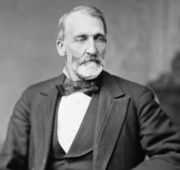
|
| Charles Burpee |
The late Charles Burpee had a little speech he made everywhere he got a chance. "If you want to be happy for a day," he said, "Get drunk." If you want to be happy for a month, get married. But if you want to be happy for a lifetime -- get a garden." A lot of people who were born and bred in condos think Burpee must have been a little strange, but even they often tend house plants and window boxes.
 Gardening not only takes time, it takes time during the day. 
|
Gardening may be fun, but it takes time. It particularly takes time during daylight without rain, which is in much shorter supply during short springtime days, and equally short days in the harvest season. In fact, the most critical part of home gardening is to do your planting and weeding and harvesting at just the right time. It's useful to have neighbors who will tell you what grows well in the neighborhood, and where to buy plants and fertilizers. After that, most amateur gardeners are good to go, once they buy a gardening how-to book. Long ago, one other way to improve your garden was to send some daughters to Shipley School, which always dominated the prizes at the Philadelphia Flower Show. However, Shipley has since gone co-ed, and there may have been many other changes.
So, being retired makes gardening possible for people who like it well enough, but never found time at the right season. It's one of the reasons to be reluctant to sell your house which is now too big for you when you retire. Now, at last, you can get things mulched and composted and planted and fertilized and pruned. Especially pruning. There is a tendency in suburban living to plant a lot of bushes and groundcover, and then forget them for twenty years. After a while, the house disappears in the bushes and the whole place looks as though it had been abandoned. It can take two years of pruning and fertilizing to get the place salable; and when you get it salable, you start to lose your interest in selling it. You begin to suspect your neighbors have been prodded into competitive gardening; mustn't let them show you up. Real estate agents who have become unexpectedly friendly tell you neighborhood house prices are holding up nicely. Not now, go away.
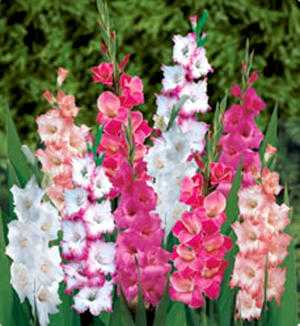
|
| Gladiolus |
A few miles further out from suburbia, in exurbia, notice that farmers seldom bother much with landscaping and flower gardening. A former patient of mine once plowed up half an acre and planted gladioli. And then he sold the cut gladioli to a local florist. Houses in the suburbs have foundation planting, azalea usually and rhodedendron right next to the house. Farmers may have just as nice a masonry house, but the lawn grows right up to the foundation wall of the house. Sometimes there is a flowering shrub standing lonesome on the property, usually not even that. If you spend all day every day in the agriculture business, you lose your interest in flower gardens as a hobby. But notice where that has never been true, in Tidewater Virginia and the rest of the deep South. It's not politically correct to say so, but slavery had its advantages for the owners. Once you go beyond having foundation plantings and a kitchen garden, you probably have to have some hired help to garden in a notable way. It's been a help to have power mowers and clippers, fertilizer spreaders and underground sprinkling systems; they just about balance out the loss of gardening assistance from working wives, and the extra time spent commuting extra miles. If a property has been neglected for decades, it's almost a necessity to hire professional help for one or two years to get it into shape. After the work is reduced to maintenance and tinkering, one retired person can handle it with pleasure. If you have kind friends and neighbors, you will learn from them about the choicer seed and plant catalogs, especially those who deliver their plants at just the right time in the season.
Some people prefer vegetables and spices. Tomatoes are a favorite place to begin, and cucumbers. Woodruff is nice as a ground cover and turns cheap white wine into May wine. Scallions and basil are nice. But if you are really serious about vegetables you will elevate the beds a foot above the ground, and it starts to look a little tacky. A compost heap, on the other hand, is unobtrusive and can be made quite elegant. One neighbor boasted he was going to hold cocktail parties in his compost heap.
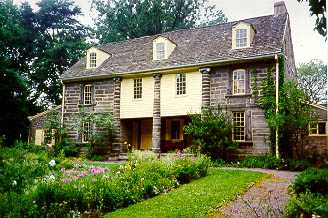
|
| John Bartram's farm and garden |
Given the chance, it's worthwhile to tour the various show gardens and arboretums in the Philadelphia neighborhoods. John Bartram's farm and garden is right in the center of the city, the way it always has been for the last three hundred years. Bartram hiked all over colonial America, collecting strange plants and flowers for resale. But most of his business was not in Philadelphia or even in America, it was in England. He had a close friend, Peter Collison, who acted as marketing agent if not business partner in Great Britain, where gardening became a major occupation of the great landed estates that American tourists now take such trouble to visit. Obviously, quite obviously, it takes staff to keep such places up. Retirement communities can do the same in a communal way if they could only get themselves pulled together.
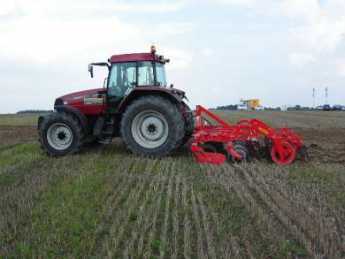
|
| Farming |
The subject of tomatoes is a sad one for the Garden State. Because of its sandy soil, southern New Jersey is especially favorable for tomatoes, and cranberries, and peas and beans. New Jersey was once a great truck farm state. Fifty years ago, Campbell Soup would bring in vast heaps of tomatoes to the soup factory in Camden, and they were very good tomatoes indeed. The tomato plants would boom continuously all summer, and vast hordes of tomato pickers would continuously harvest the crop until the first hard frost. However, a new breed of tomato plant was developed, which bloomed and ripened all at once. That was very suitable for mechanical tomato-pickers to harvest, human pickers were no longer needed to tell ripe ones from green ones. So the tomato industry picked up and moved to California, where they can grow three crops a year, harvest them with machines, and improve the bottom line for Campbell Soup. Cranberries went the other way, into the pine barrens, and one family the Haines organized a farmers cooperative called Ocean Spray which bought up almost all of the suitable bogs. Even the Journal of the American Medical Association will attest to the merit of cranberry juice for kidney infections, to the point where it has become a little hard to find cranberries in berry form for Thanksgiving and Christmas. Further south in New Jersey, the canneries organized the local farmers into growing a lot of one kind of vegetable for canning purposes. In the 1920s, however, one Frank Birdseye learned about the value of quick freezing from the Esquimos, and after applying it first to frozen fish, extended it into the various vegetables formerly organized around canning companies. You can now drive for miles past vegetable farms, without seeing a farmhouse. Quakers catch on quick; the same is true in Chester County, Pennsylvania, where the Brock family holds sway.
REFERENCES
| The Pine Barrens: John McPhee: ISBN-13: 978-0374514426 | Amazon |
Gardens for Posterity

|
| J. B. Garden |
We must be indebted to "Several Anonymous Philadelphians" who wrote a book published in 1956 called Philadelphia Scrapple, now out of print but subtitled "Whimsical Bits Anent Eccentricities and the City's Oddities." The Athenaeum librarian has carefully penciled in the names of Harold Donaldson Eberlein and Mrs. Henry Cadwalader as the probable authors of this work, and it's likely that is the fact of it.
Chapter XIV of "Philadelphia Scrapple" discusses a class of notable public gardens not designed to be show gardens, but originally the hobbies or passions of the original owner for private enjoyment, and later were opened to the public. These abound in Philadelphia, sometimes somewhat decayed, often truncated as the land was sold off, but constantly increasing in interest as the boxwood, trees, and shrubs continue to grow in size and rarity. The Anonymous Philadelphians have classed these lovely and somewhat unknown places as "Gardens for Posterity". Quite often, the estate houses to which they belong are better known than their gardens, and the original owners just regarded their gardens as a normal part of the house.
While there are dozens of such places, the more notable ones are Grumblethorpe in Germantown, The Grange in Delaware County, Andalusia along the Delaware, and two famous gardens in decrepit neighborhoods along the lower Schuylkill, John Bartram's Gardens and William Hamilton's ("Woodlands"). There is a record that the Continental Congress once adjourned to visit Bartram's garden, and Hamilton's garden is mentioned by several famous Revolutionary figures since it was on what was then the main route from Philadelphia to the Southern Colonies. John Wister's 1744 garden at Grumblethorpe was 188 by 450 feet in size; some of the boxwood have had a long time to grow.

|
| Pennsylvania Hospital |
To these should be added the hospital gardens at the Pennsylvania Hospital, at Friends Hospital along Roosevelt Boulevard, and the garden of Chester-Crozier Hospital, all of which are especially spectacular in early May when the Azaleas are in bloom. Just about every surviving mansion of colonial rich folks had such a garden at one time.
And tucked away behind many current mansions are lovely gardens that are considered to be just as private as their living rooms. While they are proudly displayed to friends, strangers knocking at the garden door would be considered the height of rudeness. It will take another generation or so for them to be thrown open to the public. By that time, who knows what state of repair they will be in.
For a unified access point for 30 gardens in the Philadelphia area, try www.greaterphiladelphiagardens.org
Haddonfield Blooming Outdoors, Year-Round
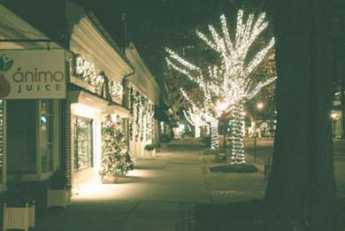
|
| Haddonfield Christmas Lights |
DECEMBER. The last of the outdoor blooms disappear at Thanksgiving. The last fall-blooming (Sasanqua) camellias, witch hazels and surviving rose bushes finish up, and the glorious maple trees have lost their fall foliage. In a warm year, the lawns remain green through Christmas, while the town lights up its trees and shrubs, and doorways, and lamp posts. The church carillon plays carols; it gets dark early. Old timers tell you of once riding to Moorestown for Christmas in a one-horse open sleigh. Winters are definitely getting warmer, but it's unclear whether this has to do with global warming or just hot water from a million drain-pipes warming up the rivers. The Philadelphia water department reports it extracts seven times as much water from the river as flows past from Torresdale to Marcus Hook. Each drop must go through seven sewage systems during that transit. Warmer weather or not, one gets to wishing the home oil delivery services would post their prices on big signs, the way gas stations do. Price controls are abhorrent, but sometimes the competitive marketplace could use a little help.
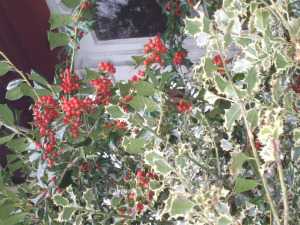
|
| Holly Berries |
JANUARY'S Ice and snow, as sung by Flanders and Swann, make the nose and fingers glow. There's not much blooming outdoors along the Atlantic coast north of Cape Hatteras in January, although the holly berries are still colorful, especially when surrounded by a thin dusting of snow. There is at least one Haddonfield family, the Coffins, who make a hobby of growing a wide variety of holly variants, many of them quite hard to grow. For some semblance of outdoor color in January, however, red berries on a tall bush show up best.
In my family, we also resort to Christmas cactus for flowers at this time of the year. It's a house plant, however, and it's a succulent, not a true cactus. In spite of the name, it only reliably blooms at Christmas if you force it to. Our formula is to stop watering it at Hallow E'en and resume watering at Thanksgiving, keeping the plant in semi-darkness during that period. Even so, it's more naturally a January bloomer, and among the easiest indoor plants to maintain. Our Christmas cactus plant is in its fourth generation within our family, with three living generations maintaining descendants of the original plant. Grandma's Christmas cactus is a living link within the family, helping us to remember who we are.
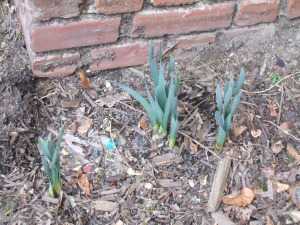
|
| Early Sprouts |
FEBRUARY'S slush and sleet, sing the Englishmen, freeze the toes right off your feet. Toward the end of the month in one of Haddonfield's milder winters, you can expect the snowdrops to flower around the base of dormant dogwood trees. These bulb plants are not very showy except for being the only thing in bloom, so plant a lot of them in clusters in the early fall, using loose soil so they can naturalize. Generally speaking, rabbits leave them alone, and in a week or so they are joined by Snowdrops, Glory of the Snow, and FSquill. The leaf fall from dogwood trees from is so dense you probably find bare ground around the base of the tree; needs something to brighten it up. The red holly berries are still on the bush; if you are lucky you have varieties of holly with white stripes on the leaves, although variegated plants are less hardy than the plain green ones. During a mild snap, daffodils poke up spikes of leaves, and a few of them have tinges of yellow. Haddonfield can get a ton of snow in February, but not every year. Some years are so mild they snatch away all the fun from neighbors who take cruises or go to southern climes for an unnatural suntan, but older residents can remember years when the Delaware River froze over. The early blooming magnolias are in bud, offering promise of what is to come. Almost everyone's lawn is a dormant brown.

|
| Snowdrops |
MARCH arrived like a lamb this year, not every year. After a late 5" snowfall melted, the snowdrops carpeted the beds under the dogwood trees. The snowdrop idea is spreading; several neighbors have clumps of them. Plant them in clusters, not strings; in loose soil, they naturalize freely. Daylight savings time arrived, making a lot of people late for church, but helping to give the feeling of spring, which isn't officially here until March 21. The daffodils are up, showing tips of yellow. Magnolias are in bud, the grass is brown, but peppered with shoots of Star of Bethlehem. The star plants are nice but thrive in muddy areas to the point they seem like weeds. As bulb plants, Star of Bethlehem come up in the spring looking like rich green early grass. Since no chemicals seem to affect them, the best you can do is mow the fresh-looking "grass" as early and as close as you can; it retards them, maybe making them die out. If you let them bloom and go to seed, you are lost. Star of Bethlehem dries up and dies on the first really warm day, leaving a bare patch in the lawn, which crabgrass is happy to fill up. March 12: Crocus, out of nowhere, blooming profusely before the daffodils make the leap. The first year you plant bulbs, they come up slowly; in years after that, they seem to jump out of the ground. Planting a few new ones every year is a way to extend the season. Sooner or later the crocus will die out; better to stick with snowdrops and squill, which will usually naturalize. By the end of March, the crocuses are fully out, the Glory of the Snow is truly glorious, the squill abundantly naturalizing in the lawn. are suddenly in full bloom because the buds are hidden under the leaves until the flowers push forward. Hellebore gets better every year, filling up shady places and somehow repellent to rodents and deer. The opposite is true of hyacinths, which get a great start but are quickly eaten by rabbits attracted by the nice odor. Forsythia are starting to blossom, sort of straggly if wild, but brilliant yellow if . Lots and lots of buds are appearing on the bushes.

|
| Forsythia |
April Fool's day really starts the main season for Haddonfield blooming. The most striking announcement that Haddonfield is ready to go comes from the magnolia trees, because they are thirty or forty feet high, completely covered with bloom. Depending on the rainfall, and whether you fertilized adequately, the lawns are now green. Most people start mowing their lawns a week or so too late, leaving the brown stubs of last year's grass showing, and allowing the confounded Star of Bethlehem to get a start. Back down at ground level, the clumps of Glory of the Snow and Squill make a very welcome show at this time of year, but the Snowdrops are pretty well over. If you are doing this sort of small-bulb edging, it's best to mix all three in the same bed to extend the small-bulb season. Flowering quince trees (or bushes, really) come out on April Fool's day, but they are easily nipped by a cold snap, and revived by warm weather. In some years when the temperature hovers around the freezing point, it is possible to have three different bloomings of flowering quince, extending over several weeks. The Hellebore stays in bloom for several weeks in April, although the foliage grows up and hides the blossoms. If you plant magic lily among the Hellebore, the leaf fronds will mix among them and then die down; the tall lily blossoms appear "like magic" in August. Daffodils are in abundance at this time, in case Wordsworth is watching, making a ground-level yellow display underneath the yellow forsythia, also in full bloom. Blooming at the same time are the mucronulatum azaleas, which are really rhodedendrons, showing a nice lavender color. Like the forsythia, the wild types are rather scrawny and sparse, while the hybrids have thickly blossomed with a brighter hue. Eat your heart out, neighbors; with these early bloomers we can have a showy spring display a month earlier, at a time when you are hungry for spring color. Notice there are four common plantings which are broad-leafed but retain their leaves all winter. Evergreens with needles, of course, but in addition the Korean dogwood is green all winter, the magnolias have shiny leaves year-round, and the scuba. Acuba are a very worthwhile addition to any garden, because they flourish in shade and sun, are simple to transplant just from sticking bare shoots in the ground, and quickly hide garbage cans, garage entrances, etc. They have a spectacular red berry hidden under the top leaves; trim them down six inches and you will see bright red berries from December to May. They aren't blossoms but are just as colorful. Some people plant crocus and hyacynths for this season, but my advice is they are just too attractive for rabbits when you can fill the same space with daffodils and Glory of the Snow. Tulips? Well, they have to be dug up every year and replanted, and then the dead blossoms have to be trimmed after they bloom; too much trouble for me. Lilacs? Well T.S. Eliot made them famous in the Waste Land but they require alkaline soil to thrive; Haddonfield soil is naturally too acid for lilacs unless you keep putting lime on them. If you come to Haddonfield and stay for years (why not?) you concentrate on things that are low-maintenance. People who move into town from Michigan are forever planting lilac, crocus, and tulips, but that's high-maintenance in Haddonfield.

|
| Azalea |
April 7: The parade of colors is beginning. Flowering fruit trees, flowering apple trees, cherries are in abundance throughout southern New Jersey. In center city Philadelphia, someone had the splendid idea of planting Ginkgo trees along the sidewalks. They look pretty much like flowering apple trees but require very little water so they become the urban favorite. When you plant flowering trees, it may take ten or more years before you see what the effect is, especially how the color fits in with the surroundings; and by then it is too late. Latecomers to the garden competition have a better chance to alternate a contrasting color. When there's nothing else in bloom, white is pretty spectacular. But when every tree is the same, it can be a little boring. For example, this is cherry blossom time in Japan, but the Japanese have so over-planted pink cherry trees for the season that although overwhelming at first, eventually the universal pinkness is pretty boring indeed. Meanwhile, all of the deciduous trees are starting to leaf out, but haven't reached the point of identifiable leaves. In many ways, this is the most beautiful brief season of the year, as every tree shows lacy tracery against the sky, but only for a few hours before the leaves appear.
April 16: The pachysandra ground cover is covered with clusters of little white flowers, which usually last for less than a week. It's hard to justify planting them for that, but important to remember an old maxim: That which grows on bare ground under a Norway maple is pachysandra -- maybe. For this purpose, Haddonfield used to have a great deal of Periwinkle, whose bright blue flowers seem somewhat more persistent because they do not all come into bloom at once. Periwinkle takes a fair amount of care, however, particularly to rake the Maple leaves away in the Fall without uprooting the ground cover, water in the summer, fertilize in the Fall; so it's falling off in popularity. If you like little blue flowers that are easier to manage, try Forget-me-nots, which come into bloom at the end of April and persist for a couple of weeks. This the magic time in South Jersey, where all the trees seem lacy with early leaf, and the laziness is echoed by Japanese cherry trees, star magnolia, and forsythia; it's a pity this wonderful moment only lasts a few days. The grass is generally green, but still growing slowly.

|
| Pink Dogwood |
MAY is heavenly in Haddonfield. Three main acid-loving plants dominate the scene: azalea, dogwood
Little blue blossoms as a ground cover are another garden feature which can give the appearance of an extended season. The glory of the Snow is planted as bulbs in the fall, coming up just as the snowdrops fade away. And then the little blue flowers of periwinkle take over as a ground cover when the forsythia is out, followed by Forget-Me-Nots during the azalea season. Grape hyacinth fit in here, too. Bulbs, ground covers, and perennials are very different sorts of plants, but the low-growing little blue flowers are much the same at a distance and can give the appearance of almost two months of continuous garden effect. Along with lily of the valley, which has a sweet fragrance, it is possible to replace the bare-earth appearance of a landscaper's commercial flowerbed with a display that is fun to watch in its subtle variations -- almost all spring long. Don't forget a patch of Woodruff, which makes a nice ground cover like pachysandra, with the bonus that a few blossoms floating in a bottle of cheap white wine convert it into delightful May Wine, Haddonfield style.
If you drive around Haddonfield in the spring, you can come across occasional homeowners who have gone too far with azaleas. They probably didn't realize what they were doing when they installed far too many azaleas of different color and habit as small plantings. But after twenty years, these bushes will grow pretty big and shaggy, looking especially overdone when one house is like this, but all the neighbors have nothing but green yards. This problem can be addressed by removing a few of the biggest bushes, and less appropriately, by trimming them like hedges. Overdone gardens like this need to be pruned, and rather severely. The best time to do it is just after the blooming has stopped, which is also the time when the recollection of kitchiness is most acute. These people mean well, so be kind to them.
May 15. The trees are almost completely leafed out, and the grass is lush green. It's easy to be fooled by the grass, which can contain a lot of annual bluegrass and clipped-off Star of Bethlehem which will die off on the first really warm day, usually in June, leaving bare spots. What you need is perennial bluegrass, preferably of several varieties to resist diseases. Matching the full leaf-out of the trees are the hybrid rhododendrons, which are essentially the same as azaleas but taller and somewhat showier. They are less hardy than other rhododendrons; sometimes six or seven of them will be killed by a sudden cold snap, ruining your garden effect; so don't depend on them exclusively. Wegelia is out now, with nice effect, too.
Memorial Day used to be the last day of May, but to create three-day weekends, it now varies in timing by several days. In some regions, it's traditional to look for peonies, all crawling with ants, on Memorial Day, but in Haddonfield, it's the time for Mountain Laurel to be in full bloom. It takes ten to fifty years to produce an effective laurel bush out of a puny little potted plant, but when you do grow one, it makes a pretty spectacular Memorial Day. Laurel is the state flower of New Jersey and Pennsylvania, but it seems less popular as a garden plant than it once was. There's also the mean rumor that honey from laurel blossoms is poisonous, but it's hard to get scientific verification of that. So many wildflowers are in bloom in late Spring, it seems relevant that the documented episodes of poisoning mostly date from the Civil War when both Northern and Southern armies were foraging in the North and South Carolina mountain wilderness. Belladonna would easily explain the symptoms the soldiers reported. There's still a Memorial Day parade in Haddonfield on Memorial Day, now much smaller than the one on the Fourth of July, although fifty years ago it was the other way around. Very likely, the Civil War veterans died off and World War I veterans favored Armistice Day. The American Legion, now mostly World War II veterans, has taken up Memorial Day, while the Veterans of Foreign Wars (originally Spanish American War, now Vietnam veterans) seem to like Independence Day. It does seem we have too many wars because it's possible to think of several others that haven't even adopted a parade.
JUNE in Haddonfield is usually a month with two seasons, late spring and early summer. At the start of the month, the left-overs from late May are still blooming, but winding down. The Mountain Laurel and hybrid rhododendrons start the month in full bloom, and then gradually fade out by about the tenth of June. Sweet magnolias come out then, with rather amazingly big flower buds. There are Easter lilies, and roses in great abundance. Astilbe in several colors is at the base of the larger bushes, and the lawns are still richly green, even bluish tinted. There are bunnies running around aimlessly, and squirrels seriously pursuing their tasks; comparatively few birds are on the ground, but up in the trees there is a great abundance of songbirds, especially early in the morning. They better watch out, a neighbor reports nesting hawks, and those owls are somewhere around.
June 15. The early June blooms are fading, but some straggler azaleas and hybrid rhododendrons persist, especially in shady areas. But the middle of June is the time for the hydrangea to pop out, and if you have taken care, there will be several interesting varieties in several colors. The Korean dogwood is just starting to blossom, about the time you gave up and assumed they never would. The blossoms (corms) start out tinted green and then turn white as they grow in size, and for some reasons, the tree will blossom in some areas well before others. This tree looks deciduous, but in Haddonfield at least the leaves remain green on the trees all winter long. And now, the wild rhododendron starts to blossom, continuing up to about the Fourth of July. These bushes are big, and they bloom abundantly, but the blossoms tend to be deep within the foliage, bloom sequentially instead of all at once, and are thus much less showy than the hybrids. But if they have been planted near the outside of a window, the blossoms are quite nice when viewed from inside the house. Sort of house plants, growing outside. Be aware of a sudden burst of hot weather. The Star of Bethlehem will suddenly grow brown, and the annual bluegrass will die as well. his is the moment in the season when a good lawn suddenly looks second-rate, but a really really good lawn just shows 'em all up. Merion bluegrass; there's nothing like it.

|
| Independence Day |
JULY'S first week revolves around the celebration of Independence Day, and in Haddonfield that means the Parade. Since the Declaration was ratified and the State of New Jersey was then immediately founded in the Indian King Tavern, the excitement is natural enough. There are fireworks and antique cars, string bands and bagpipers, service clubs and neighborhood displays, but any old-timer will tell you the central excitement of the parade and the memories generated, focus on the little kids with decorated bicycles. As far as flowers are concerned, the main display is the wild rhododendrons, with daylilies starting up, and hydrangea of many colors. There are a few Southern Magnolias, especially one in front of the Episcopal Church, with flowers as big as dinner plates, but most of these flowering trees have been planted fairly recently so the blooms are sparse. Give them a few good growing seasons before they make an impact on the town. By mid-July, most of the color is coming from window boxes and perennials along the borders of the lawns. Here's one thought about nature in the summer: Although the dominant front-yard color in Haddonfield in July and August is green (the flowering annuals and perennials are mostly in the back yards), there is the question of insects and birds. The buddleia plant attracts butterflies and hummingbirds, honeybees are attracted by the flowers of Hosta, and phlox attracts lots of bumblebees. We're in the migratory path for birds, so there are spring and fall migrants; nesting birds predominate in hot weather, so that's what should be attracted to bird feeders with sunflower seeds. It isn't unusual for a house to have eight or ten bird feeders, where the main problem is squirrels, lots and lots of squirrels. Chipmunks and squirrels are fun to watch, just like hummingbirds and bumblebees, but you should give some thought to what kind of ecosystem you hope to promote.
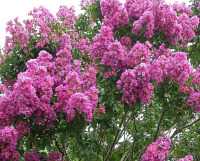
|
| Crape Myrtle |
AUGUST in Haddonfield features Crape Myrtle, which comes in many shades of red, and many sizes from three-foot bushes to thirty-foot trees. They are a southern flowering bush, just barely hardy this far North, so it pays to shelter them a little when you plant them. For the most part, blooming flowers in Haddonfield are mostly found in the back yards during August. The annuals are too numerous to mention, so an experienced gardener groups color schemes. Another trick is to plant seven-foot sunflowers in the back, five-foot gladioli in front of them, and three-foot phlox in front of that. Let's not forget to mention crabgrass. When the ground is wet they are relatively easy to pull up, when they get to be twelve-inch mounds they are almost impossible to pull. Newcomers are pleased crabgrass is such a quick-growing thick green turf, but they are the enemy and don't you forget it. They are an annual, so the first frost turns them brown, and they seed themselves relentlessly. Part of enjoying a garden is learning to enjoy pulling up crabgrass.
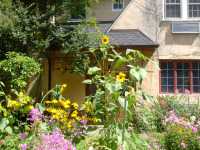
|
| sunflowers |
SEPTEMBER, remember, as the mariners say about hurricanes. Somewhere it is written that 80% of the rainfall along the Atlantic coast in the autumn is caused by coastal storms, sometimes hurricanes, sometimes nor'easters, sometimes just storms. Variability of the rainfall in autumn is one of the main causes of variability in spring gardens. Since September is the perfect time to put in new grass seed, the quality of lawns has a lot to do with coastal storms the year before. It's almost three months since the days started getting shorter on June 21, so the flowering plants are starting to fade. Crape myrtle is good for the first two weeks, and spider plant gets three or four feet tall, an annual that looks like a flowering bush. The August blooms, of sunflowers and phlox, are starting to droop a little. It's definitely time to go to the local plant store and get a dozen or so chrysanthemum plants. Yes, it's possible to debut them in the summer, prune them into tight bushes, and have a perennial that comes back every year. But you have to be a slave to chrysanthemums all spring and summer in order to have anything as full and compact as you can buy at the store. There are lots of 'mums in Haddonfield all fall, but almost all of them are purchased in pots in September.
September is the critical moment for good lawns. Permanent lawns go dormant around the end of August, and even the best of them look a little shaggy then. The most neglected lawns die at this time, for lack of water, fertilizer, excess heat, and so on. However, permanent lawns with lots of bluegrass will respond to this weather signal by thickening up, one shoot dividing into three or four, and after a week or ten days will produce the best lawn of the year. Now is the time to fertilize, now is the time to reseed bare patches; every few years it may be time to thatch and thin out, although the lawn will look terrible for a month after hatching. If you seed, mainly use bluegrass plus a little fescue for shady areas. When reading the box of seed, just ignore the ryegrass, even if it says "permanent" ryegrass. Treat ryegrass as just so much sand diluting the good grasses; only use it if you are planning a quick sale of your house and want it to look nice for a few months. The secret of a good lawn is fertilizer, but of course, you can't grow wheat if you plant corn, you must give it some good seed worth fertilizing.

|
| Fall Leaves |
OCTOBER, according to the New England college drinking songs, is when the leaves do fall, so early in October. However, those who prefer the advantages of living in Haddonfield have the additional advantage of finding that in Haddonfield, the leaves turn brilliant and start to fall, so late in October. The rest of the color in October is left-over from the September fall revival. Lots of colored leaves lead to lots of leaves on the ground to rake. And you better rake them off the lawn, too, or else they will rot and kill the grass, leading to bare ground, which washes away from the tree roots and looks just terrible. So rake, and rake cheerfully. Blessings on the Borough, which sends trucks around to suck them up into trucks and takes them away, so they don't clog up the storm sewers with disheartening floods in the streets when it rains, as it frequently does when fall hurricanes sent storms up our way. Remember, do your share of leaf raking, and do it both quickly and cheerfully.

|
| Chrysanthemum |
NOVEMBER has some late-blooming flowers, especially chrysanthemums and others of what Linnaeus called the Aster family, but which DNA studies show are just late-blooming flowers that sort of look like chrysanthemums. We're not going to get into this argument since the use of DNA typing seems to lead to placing the typical florist's chrysanthemum outside the chrysanthemum family, and endless other confusion which would serve this website no particular good until it settles down in forty or fifty years. A few stragglers like the spider plant will continue to bloom into November unless there's an early frost, along with "Asters" and dahlias, but all of that is a lot of trouble for a suburban landscape after school has begun, and the leaves are piling up, taking time to rake during short daylight hours. Be content with the glorious colors of the many maple trees, especially those lining the long straight streets like golden arches. We don't have much red color in the maples, such as you see in Vermont, so it's a good idea to plant some Euonymus bushes which will soon grow into trees and have stunning scarlet leaves in early November. The one really good fall-blooming shrub is the fall Carmelia, which comes in a variety of colors, but the white shows up best in my opinion. Camellias, whether of the fall-blooming or Japonica variety, are truly best suited to more southern climates. However, if you can find a place that is both sunny and protected -- a difficult combination to find -- they can grow to a height of six or eight feet, covered with blossoms at a time when foundation shrubbery is ordinarily pretty drab. After ten or fifteen years you can expect an early frost finally to get them, so don't be disheartened if that happens, just start over. If you have the sort of employer who transfers people every two years, just stick with pots of florists' chrysanthemums.

|
| The glory of the Snow |

|
| Spring Budding |

|
| Spring Budding |

|
| Daffodils |

|
| Crocus |

|
| Japanese Cherry |

|
| Grape Hyacinth |

|
| Narcissus |
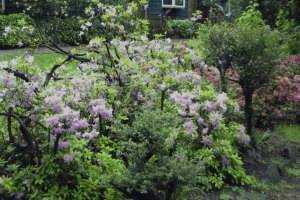
|
| Azalea |

|
| Wisteria |

|
| Lily of Valley |

|
| Magnolia |

|
| Money Bush |

|
| Forget Me Nots |

|
| Tezou |
Harriton House
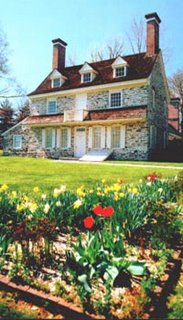
|
| Harriton House |
Three hundred years ago, in 1704, Roland Ellis acquired 700 acres of the Welsh Barony in what is commonly called Philadelphia Main Line and built a palatial house on it. He called his homestead Bryn Mawr, or great hill, after his ancestral home in Wales of the same name, thereby explaining why Bryn Mawr College and Bryn Mawr town have the name but are not notably situated on hills. The town of Bryn Mawr was once called Humphryville. But Bryn Mawr sounded nicer, even though there are plenty of Humphries still around to defend the older designation.
About fifty thousand acres were set aside by William Penn as the Welsh Barony, and there was the willingness to allow it to be self-governing, although that didn't much happens because the inhabitants saw no point in being self-governing. Nevertheless, the term isn't just an ethnic allusion, but has some historic meaning.
In any event, Ellis proved to be an unsuccessful manager of his estate, which rather soon passed into the hands of the Harrison family, who lived on it for about two hundred years until real estate development, and the taxes related thereunto, forced the creation of a complicated arrangement, with the township of Lower Merion owning the property and a non-profit group called the Harriton Association managing it. They have luckily obtained the services of a famous curator, Bruce Gill, who does research, writes papers, and organizes programs for visitors. The neighbors in the area, all living on land that formerly belonged to the Harrisons, are said to constitute the richest neighborhood in America. By building the original farmhouse rather far from the main road (Old Gulph) and remaining surrounded by neighbors who want to have privacy, Harriton House has fewer visitors than it deserves because it is so devilish hard to find.
There was a little local skirmishing during the Revolutionary War, but the main historical significance of the House was that Charles Thomson married a Harrison and lived there all throughout the period of the Revolution and the Articles of Confederation (1774-1789) as the Secretary of the Continental Congress. His little writing desk is, therefore, the most notable piece of furniture at Harriton House since every piece of official paper involved in the whole Revolutionary episode passed through it or over it. Modern organizations would do well to notice that Thomson was not given a vote and was expected to be totally unbiased about Congressional affairs. Even in those days, there must have been cautionary experience with secretaries who tinkered with the minutes for their own preferences. It certainly was entirely fitting that this last steward of the Articles of Confederation was designated to carry the news to George Washington at Mount Vernon, that he had been elected President of the new form of government. No doubt, Washington was pleased but unsurprised to learn of it.
While Harriton House is imposing on the exterior, and was the likely prototype of many characteristic Main Line stone mansions, the inside of the house is quite primitive. In those days it was cheap to build a big house but expensive to heat it. In 1704 surrounded by a continent of a forest, firewood may not have seemed a problem, but it quickly posed a transportation problem, and later houses tended to shrink in size. In any event, the interior of the house seems strangely bleak and bare, quite in keeping with the early Quaker principle of building a structure "without paint, or other adornments". Bruce Gill spent quite a lot of time and effort to determine that the random-width flooring had never received any shellac, varnish or wax. Those are beautiful floors, but the "finish" is just three hundred years of oxidized dirt.
The original Bryn Mawr, now called Harriton House, is well worth a visit. If you can find it; GPS is the modern solution.
Highway Beautification

|
| Prince Grigory Potemkin |
Someone who has traveled in modern China -- and is at all observant -- knows that the extensive slums and trashy wastelands of the Inner Kingdom are systematically hidden from tourist's eyes by fences and plantings of tall trees. In a few years, the trees will grow a few feet taller and fully conceal what is behind them, but today modern tourist buses are high enough so you can see over the treetops if you look. When American tourists notice this, they are very smug.
The term Potemkin Village is a somewhat exaggerated term for the process Grigory Potemkin used to clean up the villages that his girlfriend Catherine the Great passed through on her visit to southern Russia and Crimea. He apparently did not construct whole fake villages as enemies claimed, but he was unnecessarily forceful,
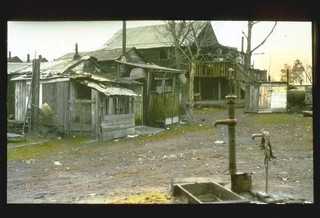
|
| West Philadelphia, at one time. |
let us say, in his efforts to smarten things up. After taking a few rides on Philadelphia's suburban commuter trains, or a boat ride up to its rivers, the idea does cross most minds that we could use a Potemkin in charge of our Streets Department, or maybe a Communist Chinese on loan. We have miles, maybe even hundreds of miles, of overgrown weeds along our embankments, spiced with the discarded trash of historic duration. Since nobody wanted to live next to coal-burning locomotives, and most people even dislike the noisy though cleaner replacements, the houses along the railroad clearly deserve to be hidden. That's true in almost every town in the world (not Japan, not Switzerland) and it's deplorably true in our Philadelphia. Seaports and riverbanks are a mess everywhere, too, and we are certainly in style in that department as well. Why can't the Schuylkill look like the Seine, next to the cathedral of Notre Dame?
So the Chinese have combined the concept of cleaning up their public spaces, which we applaud, with the concept of hiding the economic truth, which we sneer at. Maybe we should give some thought to a spin campaign, the essence of which is a metropolitan crusade to pick up the trash, build some strategic fences, and plant a whole lot of tall evergreens along with the public ways. We've made a good start with Boathouse Row; why not extend it to Gray's Ferry, or even to Norristown? The idea is not a new one; Lady Bird Johnson made it her main goal in public life.
In 1965, Lyndon Johnson used his famous powers of legislative persuasion to give his wife what she wanted. The Highway Beautification Law of 1965 was passed by Congress on Lady Bird's birthday, with everyone in the gallery dressed in evening clothes. With the vote counted and enormous standing applause registered for fifteen minutes, the whole group traveled over to the White House for a signing of the law with nineteen pens. There followed the birthday party at the White House, to end all birthday parties. Highway billboards were a thing of the past.
That was forty or so years ago, and unfortunately, the billboard companies didn't like it at all. Through administrations both Democrat and Republican, the Department of Transportation has never issued regulations, so Highway Beautification was never implemented. It represents just one more unwritten aspect of the Constitution that James Madison and his friends didn't fully anticipate.
Laurel Hill
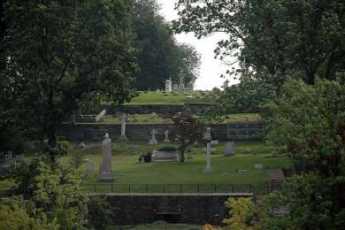
|
| Laurel Hill Cemeteries |
There are two Laurel Hill Cemeteries in Philadelphia, sort of. Although both are described as garden cemeteries, the older part in East Fairmount Park is more of a statuary cemetery or even a mausoleum cemetery. When its 74 acres filled up, the owners bought expansion land in Bala Cynwyd, which could come closer to present ideas of a memorial garden. Particularly so, when the older cemetery area started to fill in every available corner and patch and began to look overcrowded. The name was used by the Sims family for their estate on the original area. Since June-blooming mountain laurel is the Pennsylvania state flower and a vigorous grower, it seems likely the bluff overlooking the Schuylkill was once covered with it. Somehow the May-blooming azalea has become more popular throughout the region, particularly in the gardens at the foot of the Art Museum. If extended a little, merged with laurel on the bluff, and possibly with July-blooming wild rhododendron, there might someday arise quite a notable display of acid-loving flowering bushes from the Art Museum to the Wissahickon, continuously for two or three months each spring.
There are interesting transformations in the evolving history of cemeteries, best illustrated in our city by the traditions of the early Quakers when they dominated Philadelphia.

|
| Thomas Grey |
Objecting to the ornate monuments which Popes and Emperors erected for their military glory, and probably to the aristocratic custom of burying important people inside churches where they could be worshiped along with the stained-glass saints, early Quakers were reluctant to mark their own graves with headstones, or even to have their names engraved on such "markers". By contrast with the splendor accorded aristocrats, the common people in Europe were largely dumped and forgotten, providing an unfortunate contrast. During the early part of what we call the romantic period, Thomas Gray popularized these attitudes in Elegy in a Country Churchyard. To be fair about it, the early Christian Church had a strong tradition of collecting the dead of all classes into catacombs. The Romans were quite reasonably upset by the potential for spreading epidemics through people living within such arrangements, although feeding the Christians to the lions seems like an overreaction.
At any rate, and to whatever degree the French Revolution was what shattered previous traditions, the Victorian or romantic period produced a new vision: garden cemeteries in Paris.
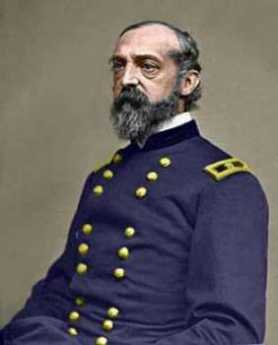
|
| George Mead |
The concept soon spread to Laurel Hill, and thence to the rest of America. Acting with what probably had some commercial motivation, cemeteries then moved away from churches to suburban parks, promoted as places of great beauty in which to stroll and hold picnics, perhaps to meditate. The private expense was not spared in statues and mausoleums, which often became display competitions between dry goods merchants and locomotive builders. Revolutionary heroes were dug up from their original graves and transported here to be more properly honored, as were some private persons whose descendants wished for more suitable recognition than conservative church rectors had offered. The Civil War created the staggering number of 632,000 war dead; based on the proportion of the population, that would be equivalent to six million in today's terms. Since they were almost all male, there must have been at least a half-million surplus women as a consequence. The nation and this almost unbelievably large cohort of single women had an impact on society for thirty or forty years after The War. Eventually, this would lead to colleges for women, suffrage and other forms of feminism, but the initial manifestations of what we now call Victorianism took the form of formalized grief, particularly the 75 National Cemeteries of crosses row on row. But private initiatives also took a variety of forms, including Laurel Hill's statuary to honor the valor of the fallen, ranked by the number of generals buried there and visits by sitting Presidents of the United States. Laurel Hill, East, holds 42 Civil War Generals. It will be recalled that Lincoln's Gettysburg Address was delivered at a much larger final resting place for fallen soldiers, but Laurel Hill had the generals, including George Gordon Meade, himself. It is probably significant that Laurel Hill West, three times as large, was opened in 1867. At the headstone of each Civil War veteran is found a metal flag-holder, put there by the Grand Army of the Republic and marked with GAR surrounding the number 1. This is the home of Post Number One, the Meade Post, the original home of this organization responsible for many patriotic movements like the Pledge of Allegiance and commemorative reunion encampments and reenactments. The main purpose of the war was to preserve the unification of a continental nation, and the GAR sought to raise patriotic consciousness to a point where fragmentation would never again be conceivable.
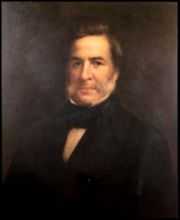
|
| John Notman |
Two names stand out in the history of these cemeteries, Notman and Bringhurst. John Notman was one of the early architects who fashioned the look and feel of Philadelphia. His identifying feature is brownstone, as seen cladding the Athenaeum building on Washington Square, and St. Marks Episcopal Church at 15th and Locust. At Laurel Hill, the main entrance confronts a brownstone sculpture by Notman of "Old Melancholy", depicting a typical Victorian romantic vision; just about all other monuments in the cemetery are either of acid rain-eroded marble or indelible granite. Brownstone from Hummelstown PA provided the characteristic look of New York residential architecture during this era. Philadelphia brownstone probably came from the same place. The other name is Bringhurst, dating back to 17th Century Germantown, long associated with the underlying sanitary purposes of the cemetery. The family finally and gladly sold the undertaking business a few decades ago.
Somehow, the image of cemeteries has now transformed from public places of meditation and reverence to places that are "spooky". Their greatest surge of visitors, these days, occurs at Halloween.
Morris Arboretum
 The former estate of John and Lydia Morris is run as a public arboretum, one of the finest in North America. 
|
Morris is the commonest Philadelphia name in the Social Register, derived largely from two unrelated Colonial families. In addition to their city mansions, both families had country estates. The country estate once belonging to the Revolutionary banker Robert Morris was Lemon Hill, just next to the Art Museum, where Fairmount Park begins. But way up at the far end of the Park, beyond Chestnut Hill, was Compton, the summer house of John and his sister Lydia Morris. This Morris family had made a fortune in iron and steel manufacture and were firmly Quaker. Both John Morris and his sister were interested in botany and had evidently decided to leave Compton to the Philadelphia Museum of Art as a public arboretum. John died first, leaving final decisions to Lydia. As the story is now related, Lydia had a heated discussion with Fiske Kimball, at the end of which the Art Museum deal was off. She turned to her neighbor Thomas Sovereign Gates for advice, and the arboretum is now spoken of as the Morris Arboretum of the University of Pennsylvania. It is also the official arboretum of the State of Pennsylvania. To be precise, the Morris Arboretum is a free-standing trust administered by the University, with the effect that five trustees provide legal assurance that the property will be managed in a way the Morrises would have wished. In Quaker parlance, Lydia possessed "steely meekness."
A public arboretum is sort of an outdoor museum of trees, bushes, and flowers, with an indirect consequence that many museum visitors take home ideas for their own gardens. Local commercial nurseries tend to learn here what is popular and what grows well in the region, so there emerges an informal collective vision of what is fashionable, scalable, and growable, with the many gardeners in the region interacting in a huge botanical conversation. The Morris Arboretum and two or three others like it go a step further. There are two regions of the world, Anatolia and China-Korea-Japan, with much the same latitude and climate as the East Coast of America. Expeditions have gone back and forth between these regions for a century, transporting novel and particularly hardy or disease-resistant specimens. An especially useful feature is that Japan and parts of Korea were never covered with glaciers, hence have many species found nowhere else in the temperate zone. Hybrids are developed among similar species found on different continents, and variants are found which particularly attract or repel the insects characteristic of each region. The Morris Arboretum is thus at the center of a worldwide mixture of horticulture and stylish outdoor fashion, affecting millions of home gardeners who may never have heard of the place.
Native Habitat
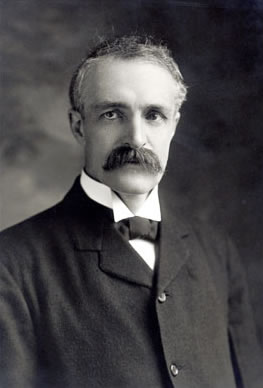
|
| Gifford Pinchot |
Teddy Roosevelt's friend Gifford Pinchot is credited with starting the nature preservation movement. He became a member of the Governor's cabinet in Pennsylvania, so Pennsylvania has long been a leader in the formation of volunteer organizations to help the cause. Sometimes the best approach is to protect the environment, letting natural forces encourage the growth of butterflies and bears in a situation favorable to them. Sometimes the approach preferred has been to pass laws protecting threatened species, like the eagle or the snail darter. Sometimes education is the tool; the more people hear of these things, the more they will be enticed to assist local efforts. The direction that Derek Stedman of Chadds Ford has taken is to help organize the Habitat Resource Network of Southeast Pennsylvania.
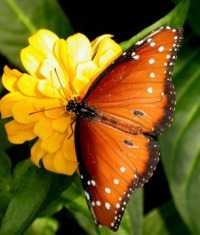
|
| butterfly |
The thought process here is indirect and gentle, but sophisticated; one might call it typically Quaker. Volunteers are urged to create a little natural habitat in their own backyards, planting and protecting plant life of the sort found in America before the European migration. If you wait, some insects which particularly favor the antique plants in your garden will make a re-appearance, and in time higher orders like birds that particularly favor those insects, will appear. The process of watching this evolution in your own backyard can be very gratifying. To stimulate such habitats, a process of conferring Natural Habitat certification has been created. In our region, there are over three thousand certified habitats.
Of course, you have to know what you are doing. Provoking people to learn more about natural processes is the whole idea. For example, milkweed. That lowly weed is the source of the only food Monarch butterflies will eat, so if you want butterflies, you want milkweed. For some reason, perhaps this one, the Monarch is repugnant to birds, so Monarchs tend to flourish once you get them started. After which, of course, they have their strange annual migration to a particular mountain in Mexico. Perhaps milkweed has something to do with that.
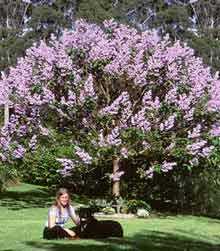
|
| Empress tree |
If you plant trees and shrubs along the bank of a stream, the shade will cool the water. That attracts certain insects, which attract certain fish. If you want to fish, plant trees. And then we veer off into defending against enemies. The banks of the Schuylkill from Grey's Ferry to the Airport are lined with oriental Empress trees, with quite pretty purple blossoms in the Spring. These trees seem to date from the early 19th Century trade in porcelain (dishes of "China" ) on sailing vessels. The dishes were packed in the discarded husks of the fruit of the Empress tree, and after unpacking, floated down the Schuylkill until some of them sprouted and took root. Empress trees are certainly an improvement over the auto junkyards hidden behind them. On the other hand, Kudzu is an oriental plant that somehow got transported here, and loved what it found in our swamplands. Everywhere you look, from Louisiana to Maine, the shoreline grasslands are a sea of towering Kudzu, green in the spring, yellow in the fall. It may have been an interesting visitor at one time, nowadays it's a noxious weed. So far at least, no animals have developed a taste for Kudzu, and no one has figured out a commercial use for it. When an invasive plant of this sort gets introduced, native habitat and its dependent animal life quickly disappear. So, in this situation, nature preservation takes the form of destroying the invader.
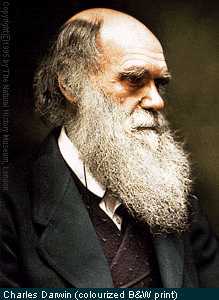
|
| Charles Darwin |
But where is Charles Darwin in all this? The survival of the fittest would suggest that successful aggressors are generally fitter, so evolution favors the victor. Perhaps swamps are somehow better for being dominated by Kudzu, pollination might be enhanced by killer bees. At first, it might seem so, but if the climate or the environment is destined to be in constantly cycling flux, diversity of species is the characteristic most highly desired. For decades, biologists have puzzled over the surprising speed of adaptation to environmental change. Mutations and minor changes in species seem to be occurring constantly, and most of them are unsuccessful changes. But when ocean currents change, or global warming occurs, or even man-made changes in the environment alter the rules, we hope somewhere a favorable modification of some species has already occurred standing ready to take advantage of the changing environment. Total eradication of species variants, even by other species which are temporarily better adapted, is undesirable. In this view, the preservation of previously successful but now struggling species is a highly worthy project. The meek, so to speak, will someday have their turn, will someday inherit the earth. For a while.
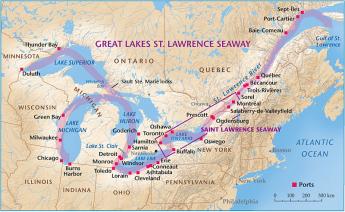
|
| St. Lawrence Seaway map |
And finally, there are variants of the human species to consider. To be completely satisfying, a commitment to preserving "native" species in the face of aggressive new invaders must apply to our own species. Surely, a devotion to preserving little plants and insects against the relentless flux of the environment does not support a doctrine of driving out Mexican and Chinese immigrants at the first sign of their appearance, like those aggressive Asian eels plaguing the St. Lawrence Seaway?. Here, the answer is yes, and no. For the most part, invasive species are aggressive mainly because they find themselves in an environment which contains no natural enemies. If that is the case, fitting the newcomers into a peaceful equilibrium is a matter of restraining their initial invasion long enough for balance to be restored through the inevitable appearance of natural enemies. So, if we apply our little nature lessons to social and economic issues related to foreign immigration, the goal becomes one of restraining an initial influx to a number which can be comfortably integrated with native tribes and clans. In the meantime, we enjoy the hybrid vigor which flourishes from exposure to new ideas and customs.
In the medium time period, that is. For the long haul, if the immigrant tribes really do have -- not merely a numerical superiority -- a genetic superiority for this environment, perhaps we natives will just have to resign ourselves to retreating into caves.
WWW.Philadelphia-Reflections.com/blog/1219.htm
Philadelphia Green
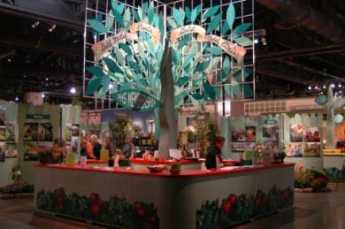
|
| Pennsylvania Horticultural |
The Philadelphia Flower Show is the best in the country. Getting crowds of visitors every March, it would get even more if Convention Hall were bigger. Obviously, it is a financial success for its owner, the Pennsylvania Horticultural Society. What six or eight million dollars of profits go for is a city-wide outdoor beautification effort called Philadelphia Green. That, too, is the biggest, oldest and best effort of its kind in the country
About a hundred employees and four thousand enthusiastic volunteers spread out over the City, to make it look half-way decent. As the momentum grows, the political strength grows, too; and politicians notice that. The ladies who run this effort hit the school system pretty hard for volunteers and the enthusiasm of inner-city kids for an activity not often seen in the asphalt jungle is very heartening. The Horticultural Society also hits local businesses with appeals; if flower gardens aren't your thing, just give us the money and we'll do it for you.
Philadelphia Green has created four hundred community gardens, seventy neighborhood parks, planted 20,000 trees in 4 years, and vigorously pursued vacant land management. If the ground is hopelessly covered with concrete they bore holes in it to drain off the water, and pour on enough dirt to get grass to grow. Among the many things which volunteers contribute, novel ideas rank high.
Someone approached the Wharton School, and it is asserted that unbeautified vacant lots are worth 18% less than average, while beautified ones are worth 30% more. Since only 10% of the City's many vacant lots have been cleaned up, there's lots of room for economic improvement in the future. But the improvement is already quite visible, isn't it?
REFERENCES
| Standardized Plant Names: American Joint Committee on Horticultural, Frederick Law Olmsted | Google Books |
Philadelphia Gardens

|
| Ernesta Drinker Ballard |
There are many show gardens, mainly on former large estates, scattered around the United States, and the ones on Southern plantations are quite famous.
However, the fact of gardening is that the climate has a lot to do with success. The really premier gardens of America are found in an East Coast strip from northern Virginia to southern Connecticut, with Philadelphia in the center of things. There is also a good-gardening area from Oregon to British Columbia, with a particularly notable garden in Vancouver, named after a sort of Philadelphian named Inazo Nitobe whose story is related in another blog. To have a really notable variation of exotic display plants, you need a lot of rain, a long cool spring, and a tradition of cultural association with the British Isles. Alkaline soils, generated by limestone, will produce a fine lilac display. Denmark would be a good place to go see that, but most of the show gardens in America are based on acid soils, with dogwood and azalea the predominant background coloration in May and June. A visitor from Michigan was once heard to ask what all the pink bushes were around Philadelphia, so it's likely the soil is not acid in Michigan. On the other hand, Korea is where wild azaleas originally came from, making the acid-soil hills crimson in the spring there. It should be noted in passing that Japan, Korea, and the Delaware Bay are on the same 40-degree latitude, but Japan escaped the loss of species caused by glaciers of the ice age.
Many of the Philadelphia suburbs have thousands of azalea bushes in each town, and hundreds if not thousands of pink and white dogwood, or purple Empress Trees, or magnolias. When you have a lot of those as background to start with, you are ready to begin planting a show garden. For that, we can largely thank John Bartram the botanist, one of the earliest Philadelphia settlers. The grounds of Friends Hospital are particularly notable for azalea display, and the Pennsylvania Hospital is pretty good, too. Although they are closer to Wilmington, the two most famous show gardens in the Philadelphia area are on DuPont properties, Winterthur, and
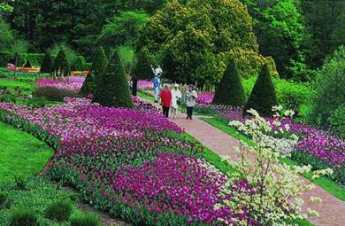
|
| Longwood Gardens |
Longwood Gardens, They feed you pretty well in the associated restaurants there, and the bookstores and gift shops are truly outstanding. But what in many ways is the best show garden in Philadelphia is Chanticleer, the former estate of a family that founded what is now Merck Pharmaceuticals, located in the suburb of Wayne, across the street from where Tracy Lord, the heroine of The Philadelphia Story, lived on two square miles of the Main Line.
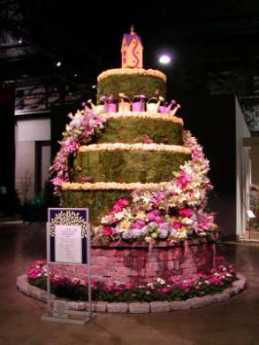
|
| Philadelphia Flower Show |
It's not clear why Chanticleer is such a well-kept secret, but it's sure worth the trip to see it at almost any season, May preferred. Interest in gardening is not limited to just a few big estates, it's a Philadelphia sport. Therefore it's not surprising to learn that the largest flower show in America is held in Philadelphia at Convention Hall in the Spring. If your feet aren't flat when you go in, they will surely be flat when you come out because a complete tour would be miles long, threading among the aisles. It's not easy to guess how much money each exhibitor spends on a display, but it's surely not a cheap hobby when you get to this level. If you notice the landscaping on public grounds in the city, it's always a fair guess that it was paid for by the profits generated by The Flower Show. Almost everybody has heard of the Burpee Seed Company, and Mr. Burpee summed up the prevailing attitude of Philadelphia gardeners: "If you want to be happy for a day -- get drunk. If you want to be happy for a week -- get married. But if you want to be happy for a lifetime -- get a garden."
REFERENCES
| Gardens of Philadelphia and the Delaware Valley William Klein Jr. ISBN-10: 1566393132 | Amazon |
The Garden Show Evolves
Adam Levine, who is the unofficial authority on the Philadelphia garden scene, has written elegant books about The Flower Show, and about the larger gardens in the region. At a recent luncheon meeting at the Franklin Inn, he traced the evolution of the Flower Show.
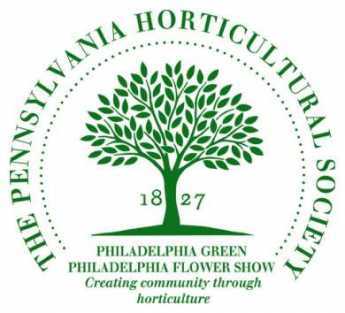
|
| The Pennsylvania Horticultural Society |
The Pennsylvania Horticultural Society was founded in 1827, and it organized the first Flower Show in 1829. For a century it was only an amateur display, very similar to the sort of local garden club display found in many towns and villages in England. The timing of such shows is dictated by the booming season of the flowers of the region, so the display depends on the dates of the local flowers, related in turn to soil and weather conditions. In the early part of the Twentieth Century, W. Atlee Burpee became the dominant force in the Philadelphia show. The show established a long tradition of domination by seed companies and nurseries, with elaborate displays which often took a week to set up, preceded by months or years of planning. The central difference in the nature of the Philadelphia show was that plants were forced into bloom, so much of its impact depended on displays which were seemingly entirely out of season. After World War II, Ernesta Ballard became the moving and controlling force, driving The Show into enormous popularity in the new larger quarters at Convention Hall. Considerable revenue was generated and used to beautify Philadelphia. The Show became the biggest, best, most popular and best funded flower show in America. Ernesta was a success.

|
| Mrs. Ballard |
Gradually, the most elaborate or dominant displays were put on by florists, using cut flowers. That was not necessarily Mrs. Ballard's original intention, although it might have been. It is the nature of plant nurseries to take away a ball of topsoil when they sell a plant, and that tends to dictate the location of the major nurseries in places where farmers are willing to ruin the land for farming, looking to speculate on suburban development. They thus are usually rural or exurban, because prime farmland is too expensive. Obviously, nurseries are pressed outward from the rim of the expanding city, and may even be forced to locate at a considerable distance away. These realities of the business tend to diminish the local loyalties of the nurseries and the city to each other. Mainly, cut flower arrangements resisted this trend by using greenhouses, but air freight has now made it possible for exhibitors of live plants to come from the Netherlands, Peru, and even Korea. The Flower Show is still held in Philadelphia, but it is much less a product of Philadelphians, especially amateur Philadelphians. When large single exhibits now can cost $100,000 apiece to organize, it is not surprising that the Philadelphians who do exhibit, are members of the upper crust.
And then there are those unions. While upper crust exhibitors can afford to pay full union wages for an electrician to plug in one electrical outlet, they are instantly offended by the whole featherbedding experience of being forced to do it. And since a great many blue collar union members are hostile to any suggestion that these gentleman farmers are in any way their social superiors, they can display what is known as an attitude. Philadelphia is famous for aggressive unions, and the Convention Center is additionally notorious for unions with political clout. Somehow, the politicians in charge of this unfortunate passive-aggressive scene get control of it and are seen to get control of it. After all, snooty exhibitors are occasionally in a position to move whole factories out to the suburbs, to the general injury of the city; moving a flower show wouldn't be too hard to do. The paradox is that 70% of these union members live in the suburbs themselves. The Flower Show cannot run without the enthusiastic help of 3500 volunteers, easily turned off by muscling them. The judging is done by 175 volunteer judges from all over America, coming to Philadelphia at their own expense, for example.
The Flower Show has had memorable moments. There was a time when the Shipley School consistently won most of the prizes. There was a famous episode when the Widener Estate of Linwood had a world-famous Acacia display. When it was broken up, there was an uproar when it was given to Washington DC, instead of staying right here where it belonged. Now, the gossip is about exhibitors from Ukraine, or from Japan, making little laughable mistakes about local geography with many streets named One Way.
The Show goes on and thrives. But just what its future is going to be is unclear. The Convention Center has doubled its space, but whether it can double its business is uncertain. And the management has recently changed from leadership which had a focus on the show and regarded city beautification as something to do with left-over profits, to leadership with a primary interest in the beautification of the city. No business will thrive if it neglects its revenue stream. So, please be careful with our nice Flower Show.
REFERENCES
| Standardized Plant Names: American Joint Committee on Horticultural, Frederick Law Olmsted | Google Books |
Greenhouses
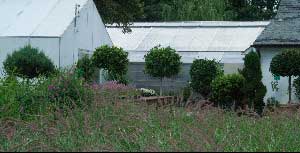
|
There are lots of mundane activities involved in having a prize show garden, like compost heaps, cold frames, mud rooms, and the like, which competitive show-gardeners never think of talking about, let alone putting on display. However, someone who feels very competitive about the garden usually lets that competitiveness spill over into the greenhouse. Most working greenhouses are muddy and disreputable-looking. When you see a big greenhouse with a spotless floor, however, you know you are learning something about the owner. When tidiness extends to spotless tools and well-sharpened pencils, there's a message. This greenhouse is not merely a tool shed, it's part of the display.
Let's talk about three outstanding greenhouses in the Philadelphia region which are adjuncts to three outstanding horticultural competitors. To spare the feelings of all concerned, the names of the owners will not be mentioned. In one case, the plants are preponderantly indoor plants, a second one is preponderantly filled with outdoor plants, and the third is full of rarities.
The greenhouse full of indoor plants reflects an owner who primarily competes in flower shows in that type of plant, it is true. But this lady obviously brings the flowers to a peak of perfection and then shifts them into the house. The result is a dining area with twenty-five potted flowers scattered tastefully around, dressing up the house. One presumes the flower pots go back to the greenhouse when they start to wilt a little, and probably an effort is made to have plants which flower at different seasons of the year. Back out in the greenhouse, there are dozens of blue ribbons arranged within picture frames to produce pleasing arrangements in themselves. Although this is a famous horticulturalist of long standing, the blue ribbons on display are only awards from fairly recent shows.

|
The second greenhouse to be mentioned is primarily devoted to outdoor plants, being bred and hybridized in controlled circumstances. The owner has created a garden in the interior of a suburban block on the Main Line, and although the houses are all part of the estate, the effect is one of the certain types of plantings in several backyards, a set of sculpted topiaries in one, a formal arrangement of boxwood designs in another, annuals in another. Although the rotation of plantings back and forth from the greenhouse is here probably more of a one-way trip, essentially the greenhouse is serving the same function as the one servicing the indoor display, a place to nurture plantings which are not quite ready for prime time.
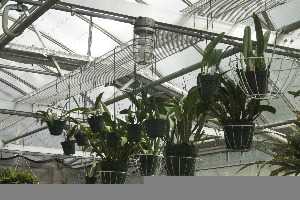
|
And the third greenhouse is primarily run by a husband and wife team of horticultural competitors. The other two gardens look as though they employed a dozen or so gardeners, while this one looks like it supports a two-person hobby. It contains a most unusual fern with its own nickname, and dozens of other display specimens of rare and unusual plants to compete in specialty shows of particular varieties. This greenhouse is just as spotless as the ones with much larger staff to do the cleaning, but it seems to have a wider variety of gardener conveniences to lighten the load and increase productivity. One quickly senses that the husband of the team pores over greenhouse catalogs and quickly adopts labor-saving devices. Space is at a premium in this greenhouse, and one guesses its results as much from a need to conserve steps as to conserve space. The effect faintly starts to resemble the jam-packed cockpit of a space-ship.
One technology advance seems to be so superior they all have it. The exterior surface of the greenhouses is not made of glass, but of polycarbonate plastic, sometimes known as "bullet-proof glass". Greenhouses seem a safe enough use for polycarbonate, although widespread use in disposable plastic water bottles seems a more questionable direction for environmental enthusiasm. This transparent material admits the light of a much wider wavelength, particularly ultra-violet, and no doubt greatly extends the season and the effectiveness of indoor nurture. From the photographer's point of view, the resulting pictures are far more pleasing, with diffused light and greater color brilliance. Thus, science has finally achieved for the Philadelphia region the same striking color of light that was so attractive to French Impressionists in southern France, and to vacationers in Hawaii.
The other thing this plastic invention has done has been to increase the general attractiveness of greenhouses. Until rather recently, it was the custom to paint white-wash on the glass and let it slowly weather away as increased sunlight is needed for the plants. Thus, greenhouses once almost always looked shabby and disreputable; not a place you would want seeing by visitors. But nowadays, you just keep them spic and span. And hold a cocktail party there.
REFERENCES
| Standardized Plant Names: American Joint Committee on Horticultural, Frederick Law Olmsted | Google Books |
Litchfield's Past

|
| King Charles II |
The state of Connecticut absolutely loathes the idea that it is influenced by neighboring New York City. But Greenwich is full of hedge funds escaping high taxes, unfortunately not by very much. New Canaan is what Greenwich used to be, a snooty New York suburb. And Litchfield seems destined to be next in line, but still able to deny it. It's charming, neatly manicured, but still affordable. Young investment bankers think of buying a weekend home there, which will become New Canaan or Greenwich by the time they retire, which on Wall Street is often sooner than they guess. Meanwhile, the restaurants struggle to present an upscale appearance. The local law school claims to be the first in America. In spite of civil appearances, however, this is the town that decided to invade Pennsylvania on three different occasions, provoking massacres of several hundred people. Litchfield derives from Lichtfeld, a place where heretics are burned. When those dreadful Baptists from Rhode Island made an appearance, the local Congregationalists were ready to take a stand. The borders of Litchfield once extended west to Wilkes Barre, but it is still puzzling to ask how these invaders crossed the Hudson and Delaware Rivers. Or how settler families marched through what is still pretty much a barren wilderness. All the while, telling themselves their destination was a paradise when even neighboring Scranton today looks down its nose at Wilkes Barre. What is this invasion trip like today, and why in the world would the Connecticut Yankees have changed it, three times?

|
| King Henry IV |
Those Yankees were almost certainly indifferent to the magnificent scenery offered the traveler of this path, especially when the fall foliage is awe-inspiring. George Washington's headquarters was to be located later at Newburgh for longer than at any other place, and thus it became the first national park monument in the country, lying across the path of the largely forgotten invaders. Unfortunately, hardly anyone even today in Connecticut knows what was notable back then, or cares to learn. Connecticut may make its living on Wall Street, but in a spiritual sense, it faces Boston. Curators at the National Park at Newburgh likewise know nothing of the Pennamite Wars. Restaurants have difficulty summoning up a hamburger; the motorist must pump his own gas. But there are clues; at least six different towns along the invasion route call themselves Milford, or New Milford, or similar. The postal service frowns on using the same name twice in a single state, else surely there would be more Milford. There are other clues. Near the end of the trip to the Wyoming Valley, can be found the "Promised Land Park". It's just past a place called "The Lord's Valley". Not far away can be found in the town of Dallas. Just why did Wilkes Barre name so many things after other places far away?
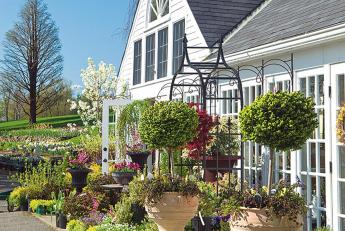
|
| White Flower Farm |
Perhaps the law school has something to do with it. Charles II of England had given Connecticut all the land to the Pacific Ocean when it was all wilderness that just about nobody wanted to own. Eighteen years later, the same king gave the same land to William Penn. Any modern lawyer, and maybe those backwoods lawyers three centuries ago, would tell you that if the King gave it away, it was no longer his. But Penn went to court with the complaint that the present king had just given it to him, and the court agreed that Penn could call the Sheriff to throw the Connecticut people out. Modern citizens would suspect bribery or other foul play, and perhaps the Yankees did, too. After all, ancestors of that King had badly mistreated some of their ancestors, so perhaps he held a grudge. Unfortunately, that's not how the law saw things at the time, and it's not entirely likely the Connecticut Yankees were being calm and straight about it. The fact was that Connecticut farmland never had much topsoil, and by this time it was worn out. Population growth pushed, and some fanciful tales of Wyoming (now Wilkes Barre) Valley's abandoned richness, pulled. They needed it, they wanted it, no one else was using it, the owner was already rich enough, and -- King Charles, that rascal, had given it to them.
The Connecticut Yankees liked to read books, so let them read Shakespeare. The so-called Henriad, those four plays concerning Henry IV and V in the 15th century, describes accurately how the King of England owned the whole island, by inheritance and by force of arms. Those nobles who followed him and brought along enough troops to win battles were each given a piece of the kingdom. But if, as quite regularly happened, one of the nobles betrayed or displeased the King, he lost his head, and his land was given to someone else. That's what it meant to be the King, and that's still largely the way it was in the Seventeenth, even early Eighteenth, century. It's true the Barons forced a king at Runnymede to obey the laws himself, Parliament asserted itself in the Sixteenth and Seventeenth centuries, the open country began to be enclosed for private ownership in the Eighteenth century -- and the fellow colonists in America would ultimately break loose from England to extend these property rights further, until in 1787 the Constitution made it final. But that's a long way from saying King Charles II couldn't do what he pleased at the time he did it, and how many girlfriends he happened to have was irrelevant to the case. William Penn was a better lawyer than anyone in Litchfield and won the case every time it came up.
And furthermore, the Connecticut folks were out of step with their friends. Eleven of the colonies were fighting for independence, and George Washington was not alone in despairing that the other two colonies were fighting, not the British, but each other. Litchfield may now have the most beautiful flower farm market in America, but at the other end of the same street, the professional forebears of the Litchfield Law School were once giving poor advice.
Green Roof at Peco
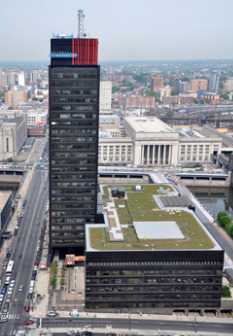
|
| PECO Building |
The Horticulture Society, the Hort to locals, recently conducted a tour of the green roof which Philadelphia Electric, now Exelon has put on the top of that big black building across the street from 30th Street Station. It's a large flat roof, and the ten varieties of sedum are quite handsome.
It's a public service activity, however, designed to help the environmental movement get up some momentum. When you look out at the Philadelphia landscape from the top of a skyscraper, it's possible to see a whole new dimension to the city. On its top, Philadelphia is one huge sea of roofs. If all of those roofs were planted, it would indeed make a huge difference of some sort. Unfortunately, the vast majority of those roofs are residential, slant-roofed, and small.
The Peco roof involved a considerable amount of tailor-made work which would have to be streamlined to make it practical for residences. First, a waterproof liner is put down, then layers of artificial plastic dirt on cushioning layers. Then the plant layer is unrolled, filled with seeds and sprouts of ten different varieties of sedum. Over time, Darwinism takes over, to make the most suitable variety of sedum thrive in the areas most advantageous to it, probably with some judicious watering to get it all started. The result is to reduce the roof temperature in summer from around 160 degrees to 70 degrees, with a consequent reduction in air conditioning costs. It does look rather pretty.
But then some hard facts of economics enter into the discussion. The roof is thought to last fifty years instead of the usual twenty since most deterioration is due to sunlight. Most homeowners don't last fifty years, however, and in fact, the average duration of ownership is around seven years. Most homeowners are skeptical they could pass on the cost to the next owner, and therefore are dubious of promised savings. Churches, museums and public buildings are therefore the most likely market in the early going. The Quakers, as usual, were the first adopters, for their administrative center at fifteenth and Cherry.
And then, there is the height of the building, which is sort of a catch-22. The taller the building, the smaller the proportion of cost savings to the owner; for the most part, the lower stories of a skyscraper are unaffected by what's on the roof. So, office buildings are unlikely to take up the green roof revolution first, or for strictly economic reasons. That leaves mostly residential roofs, which are mostly slanted in this town; the Bauhaus movement hasn't caught on much in this country. It has made more progress in Germany, and Tel Aviv is said to be predominantly Bauhaus. Consequently, we hear tales of these cities getting ahead of us, but it figures. It will be a long time before what Weir Mitchell called The Red City gets rebuilt in a flat-roof style. The proponents feel that green roofs can be adapted to slant-roof structures, but the objections to snow and rain accumulations are obvious obstacles to a city-wide transformation which would even so take a very long time.
There's even a problem with birds, who tend to drop weed seeds where ever they roost. Crabgrass, for example, is an annual which dies each year. Not everybody is willing to devote time every summer to pulling crabgrass off the roof. So, here's another advantage for skyscrapers, which is to say a disadvantage for houses. And some financial wizardry has got to be devised to pass the green roof investment of thousands of houses on to the next, skeptical, owners. And inventors and tinkerers have got to find a thousand little ways to make this process cheaper; at present, it takes too many different tradesmen and artisans to put it all together. In short, it probably costs too much at present to hope to be popular.
Our reaction here is generally favorable to the idea but skeptical of the economics. Except for altruists, idealists, and experimenters. It would seem very fine if more people took it up and perfected it. Meanwhile, it may really not be "ready", as the Quaker says.
Tyler Arboretum
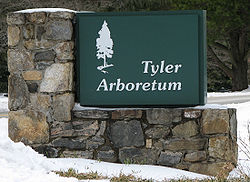
|
| Tyler Arboretum |
There are over thirty arboreta in the Philadelphia region, and one of the oldest and largest is located in Delaware County. The 650 acres of the Tyler Arboretum, adjoining 2500 acres of a state park, create a rather amazing wooded area quite close to heavily settled urban Philadelphia. The Arboretum is located on land directly deeded by William Penn, but it was privately held until 1940 and so is not as well known as several other arboreta of the region. The early Quakers, it may be recalled, often disapproved of music and "artwork", so their diversions tended to concentrate on various forms of natural science. The first director of the Tyler, Dr. John Wister, planted over 1500 azalea bushes as soon as he took office in the 1940s. They are now seventy or eighty years old, quite old and big enough to make an impressive display. Even flowering bushes seemed a little fancy to the original Quakers.
The interests of the earlier owners of the property were more focused on trees, especially conifers. The property contains several varieties of redwoods, including one impressive California redwood, said to be the largest east of the Mississippi. High above the ground, it splits into two main branches, the result of depredation by someone cutting the top off for a Christmas tree. So a large area near Painter Road is enclosed by a high iron fence, containing most of the conifer collection, and warding off the local white-tailed deer. Several colors of paint are to be seen high on many prominent trees, marking out several walking trails of varying levels of difficulty.
And then there are large plantings of milkweed, providing food for migrating butterflies; near a butterfly educational center. There are large wildflower patches and considerable recent flower plantings around the houses at the entrance. Because of the, well, Christmas tree problem, several houses on the property are still occupied.
The only serpentine barren in Delaware County is located on the property; we have described what that is all about in another essay. As you would imagine, there are great plant and flower auctions in the spring, conventions of butterfly and bird-watching groups at other times. The educational center is attracting large numbers of students of horticulture these days, and photographers. Flower gardens and photographers go together like Ike and Mike.
It's a great place for visitors, for members who are more involved, and for those with serious interests. With all that land to cover, some ardent walkers have enough ground to keep them regularly busy. Becoming a volunteer is a sign of serious interest, and that group is steadily growing. For a place that traces back to William Penn, it's slowly getting to be well known.
Ginseng Trading
DECLARATION of a state of war between Great Britain and its colonies almost immediately set loose some thinking about how to divert some of the profits and commercial arrangements of the British Empire to other owners. In particular, the American merchants began to consider how to capture colonial trade with China, or at least look into what useful gossip they could pick up in the many dealings with sea captains in port, or traders in their counting houses. The waterfront has always been a tough place, and in the seaside taverns, it can be particularly difficult to get trustworthy information or form dependable commercial alliances. So it is not entirely surprising if the captains and agents of Robert Morris found themselves in the company of many seafarers who later proved to be little short of pirates. England was conducting a lucrative trade with China, and the American colonies supplied much of the commodities. The Treaty of Paris suddenly transformed smuggling and near-piracy into open season for international trade, with much room for sharp practice.
On February 22, 1784, the Empress of China, a brand-new copper bottomed vessel built in Boston for a dubious trader named Daniel Parker, set sail from Manhattan for Canton. John Cleve Green was the captain, and ownership was a confused tangle of William Duer, John Holker, and a firm of Turnbull, Marmie, and Company which was essentially a disguised agency of Robert Morris, with Morris the dominant owner. The ship had a cargo of two commodities: 250 casks of ginseng, and twenty thousand dollars in silver. The ship would return from China a year later, bearing tea, silks, and porcelain. The world was in a post-war depression, and the numerous part owners of the venture were barely speaking to each other. But five years later it was recorded that 19 American vessels were tied up in the port of Canton. Just whose idea it was, and who gets the main credit for making it a success can be endlessly disputed, both inside and outside the courtroom. But this was in broadest outline, how the China trade began.
The rest of the story is mainly a botanical one.
Weather Man

|
| Paul Walsh |
PAUL Walsh, our local weatherman, recently addressed the GIC (Global Interdependence Center) at the Federal Reserve, and presumably because everyone talks about the weather, the meeting was well attended. While he is too experienced to get drawn into a global warming controversy, we get the general outline of his views. What we call the weather is largely a result of various clouds and wind currents blowing around the planet in response to the rotation of the planetary mixture of oceans and land masses. The familiar landscape visible to astronauts makes it easy to accept this view of things.
The global warming issue, however you explain it and where ever it may be going, is a weather cycle to be measured in centuries. Shorter cycles of about eight years in duration tend to result in American weather patterns sometimes blowing Canadian cold air toward the East Coast, and sometimes blowing California winter weather Eastward. In 2011-12 we seem to be experiencing a California winter, while the preceding two winters were unusually cold, reflecting Canadian conditions. What may or may not be happening with the hundred-year global warming cycle is not easily slipped into our daily conversations. It is probably quite irrelevant to global trends whether or not last year was a cold one, or whether our sidewalks are unusually slippery this morning.
Inquiries about the weather are the number one topic to be clicked on the Internet, reaching 17% of queries. That's nearly double the second largest category and four times the number of inquiries about the stock market. Ordinary variations of the weather have been calculated to have an economic value of $384 billion, or 3.4% of the Gross Domestic Product (GDP). Insurance claims for more severe weather abnormalities run between ten and fifty billion dollars a year. The number of hurricanes and similar disasters is highly variable, sometimes running as high as fifty in a bad year.
Predictions are improving, but ridicule of weatherman errors is still highly embarrassing to the professionals in the business. A generation ago, it was almost impossible to get a one-minute warning of an approaching tornado, but nowadays we average fourteen minutes warning for them. That's almost long enough to be useful. Hurricanes seem to be increasing in frequency, but decreasing in average intensity. But insurance claims are getting steadily higher, largely because more people are building more structures in harm's way.
Small wonder that weathermen are a cautious lot about predictions. The present party line, in case you wanted to ask, is that predictions more than ten years in advance -- are just about impossible.
American Chestnut Trees
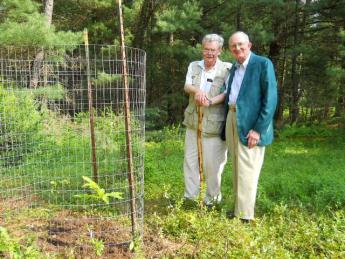
|
| American Chestnut tree |
RECENTLY, John Wenderoth of the Tyler Arboretum visited the Right Angle Club of Philadelphia, bringing an astounding account of the triumph, near-extinction, and revival of the American Chestnut tree. The Tyler Arboretum, and this man, in particular, is at the center of the movement to rescue the tree, although the modern Johnny Appleseeds of the movement seem to be a Central Pennsylvanian named Bob Leffel, and a geneticist named Charles Burnham. Together, they had the vision and drive to enlist a thousand volunteers to plant seedlings in Pennsylvania; and there are many other volunteer groups in other states within Appalachia. About 45,000 Chestnut hybrids have been planted, surrounded by wire fencing to protect the new trees until they grow too tall for deer to reach the leaves. Here's the story.
In 1904 it was estimated that a fourth of all trees in the Eastern United States were American Chestnuts. The tree typically grew to eighty feet before permanent branches took over, so the shading and tall pillars of tree trunks gave the forest a particular cathedral-like distinctiveness, much celebrated by such authors as James Fennimore Cooper. The wood of the American Chestnut tree is rot-resistant, so it was favored by carpenters, log-cabin builders, and furniture makers. It once was a major source of tannin, for leather tanning. The nuts were edible, but it has been a long time since they were available for much eating. The chestnuts you see roasted by sidewalk vendors are primarily Chinese Chestnuts, which actually come to us from South Korea. The Buckeye, or horse chestnut, produces a pretty and abundant nut but is too bitter for most tastes. For whatever reason, a fungus was first discovered to infect the chestnuts of the Bronx Zoo in 1905, attracting the attention of Teddy Roosevelt and his Progressive naturalist friends, but to little avail. The fungus (Cryptomeria parasitic) enters the tree through cracks in the bark, flourishes in the part of the tree which is above ground, leaving the roots undisturbed. Ordinarily, when this sort of thing happens, the roots send up shoots which keep the tree alive and flourishing. Unfortunately, the abundant deer of this area quickly nipped off the shoots as they appeared, and finally, the trees died. It took only a decade or so for this combination of natural enemies to wipe out the species, and today it is unusual to see lumber from this source. The forests of Chestnuts have been replaced by other trees, mostly oaks. The Chinese chestnut, however, proved to be resistant to the fungus, even though it does not grow to the same height.
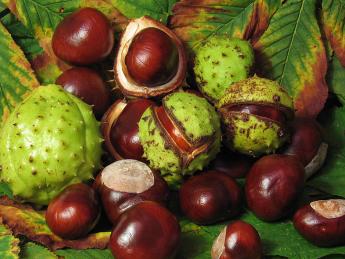
|
| Chinese Chestnuts |
After many futile but well-meaning efforts to save the trees by foresters, friends of the American Chestnut tree turned to geneticists. The goal was to transfer the fungus resistance gene from the Chinese Chestnut to a few surviving American Chestnuts. It took six or seven generations of cross-breeding to do it (four generations of seedlings, then crossing the crosses, then weeding out the undesirable offspring), but eventually, the Tyler Arboretum was supplying truckloads of seedlings to the volunteers to plant in likely places. It's going to take many years for the seedlings to grow in sufficient numbers to make an impact on our forests, and eventually on our carpenters, but that effort is underway with gusto. If anyone wants to volunteer to join this effort, there appears to be room for plenty more people to help.
Enforcing the Constitution: Civil Monetary Penalties (CMP)

|
| Founding Fathers |
The 1787 Constitution created three branches of government along with their defined powers but described no remedy for a branch overstepping its boundaries. Gradually, a system evolved for declaring some laws unconstitutional, one by one, clarifying individual issues along the way. By contrast, the founding fathers viewed the President as an agent of Congress, expecting Congress to devise controls if needed. George Washington had an intense distaste for monarchs, and eight years as Commander in Chief had exposed no taste for conflict with the Continental Congress. Unfortunately, this has proven to be unusual for Presidents, especially as popular sovereignty appears to expand the Presidential mandate. Moreover, Washington himself developed more friction with Congress during his two terms as President.
In retrospect, the main factor behind Presidential restlessness is the experience of misinterpreting the meaning of a broader electoral mandate, which can more properly be traced to hasty repair of the defects of the 1800 election process. Experience has shown that while ignoring rules invites anarchy, the impeachment of a President usually seems too drastic a remedy for unwelcome innovation while impeaching the whole Legislative Branch for failure to supervise in a general way, is incomprehensible. The President needs some sort of supervision. While the original intent was to have Congress do the supervising, the Supreme Court is now probably better suited for judging the issue of unconstitutional behavior, except for the awkwardness that the President appoints the Supreme Court. These are the simple ingredients of a solution, preferably unwritten and revolving around conferring special "standing" in special circumstances.
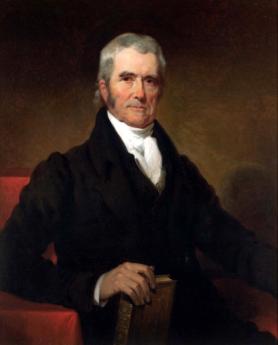
|
| Chief Justice, John Marshall |
At present, grievances tend to accumulate until someone acquires "standing" by being injured. At present it is generally true a grievance scarcely matters if no one is injured, but the exception is the lack of redress for injury to the Constitution, whereby everyone may be injured. Furthermore, actual experience with creeping boundary encroachment has mostly proved to be nuanced, rather than confrontational, gradual rather than abrupt. The descriptive example is that of a frog in a gradually heated pan of water, whereby the frog is cooked faster than he realizes he is in danger. Otherwise, the courts have evolved an unspecified balance which has proved remarkably serviceable.
It took thirty years for John MarshalI to formulate the general approach needed. In Marbury v. Madison , his first action after becoming Chief Justice, John Marshall suggested a writ of Mandamus (i.e. "We command...") from the Court might well be the first step in what he coyly described as only a hypothetical situation. Only lawyers were expected to recognize fully that If the President ignored the writ, then the grounds for impeachment might escalate, with the President forced into the role of flouting a decision of the Court. Regardless of how it stood on the original issue, the public would likely support a Court in performing its duty to make difficult decisions.
One way or another, the national issue would become one of whether the nation wished to continue with its Constitution; Marshall had only outlined the steps the process would probably take. At several points along the way, the Chief Justice would have a chance to back off. But Marshall's lifelong hatred of his cousin Thomas Jefferson was so well known there was little doubt he was serious. Knowing of his cousin's hatred for him, President Jefferson let the matter drop; subsequent Presidents followed his example. Generations of lawyers have studied this case and pondered its implications. The solution to the problem of extending it from unconstitutional laws to unconstitutional behavior, probably already exists in many minds.
Barnes Arboretum
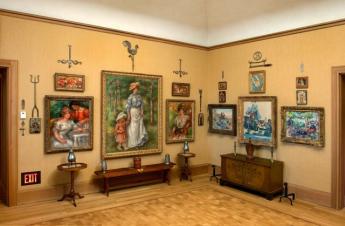
|
| The Barnes Foundation |
If you want to live on City Line Avenue, safely in Montgomery County, you put your entrance on Latches Lane, which is parallel to City Line. It used to be said that the Barnes Foundation was next to Episcopal Academy, but that has moved further West, and St. Joseph's University now owns the property. When St. Joseph's decides what to do with the land, we can possibly describe a better landmark. The Barnes Foundation has always faced away from Philadelphia and is a little hard to find, all of which may have something to do with Dr. Barnes' strong dislike of the City.
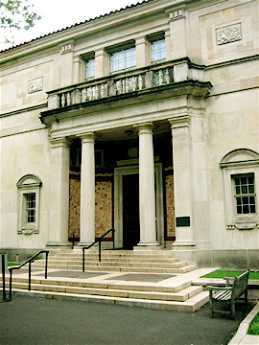
|
| The Barnes Museum |
When you go there now, the old Museum is still there, but already showing signs of neglect. The house the Barnes family lived in is still, right next door. But it's harder to move an Arboretum than a group of paintings, so the Arboretum School, which was Mrs. Barnes' hobby, is still at the same place, likely to stay awhile. It's still a very nice place to visit, especially right at Labor Day when the very large Franklinia Trees are in full bloom. Like all Franklinia trees, these are direct descendants of the only example John Bartram was able to find, in Georgia or anywhere else.
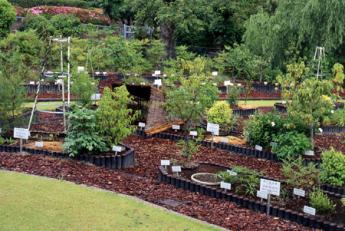
|
| Medicinal Garden |
We're going to have to leave the decision to former Governor Rendell, about what you do with an empty museum since he is said to have had a lot to do with making it that way. We came to see the Arboretum.
The first thing which strikes you is that many of the big old trees are much older than the Barnes Foundation would have been. The brochure helpfully explains that a 19th Century tree fancier started it in 1880, and the Barnes acquired it in 1922. That still wouldn't account for a massive tree which is lying on the ground all cut up, opposite the Medicinal Garden. The base of the tree must be three or more hundred years old, so perhaps there was a grove of old oaks, just over the line of William Penn's city, which every owner tended carefully until the bugs got it. There are a considerable number of Chinese trees that look about right for 1880, but without a guide, it's pretty conjectural.
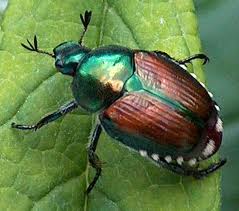
|
| Japanese Beetle |
Ever since someone imported the Japanese beetle along with some plants, to Moorestown, New Jersey, there have been laws prohibiting the importation of plants from abroad, but there must be some regulatory rigamarole which allows museums to do it. Korea and Japan are at the same latitude as Philadelphia, and the glaciers spared some ancient dinosaur food in those regions, so quite a few strange plants have come here from that source. Since the Barnes is a school, and since it only has a few acres, many if not most of the specimens in the gardens are one or two of a kind. That either means they have a feeder garden somewhere to store backups or a good relationship with government officials. Like all Arboretums, it attracts insects, so be prepared to do some swatting if you go. The school is said to be outstanding and quite conveniently located, but even just a stroll around is quite a nice way to spend a Sunday afternoon.
24 Blogs
Fernery
 Around 1840, there was a brief worldwide craze for ferns, related to the exciting discovery of their complicated reproductive process. Only one Victorian fernery still exists in North America, at the Morris Arboretum in Philadelphia.
Around 1840, there was a brief worldwide craze for ferns, related to the exciting discovery of their complicated reproductive process. Only one Victorian fernery still exists in North America, at the Morris Arboretum in Philadelphia.
Gardening Survives
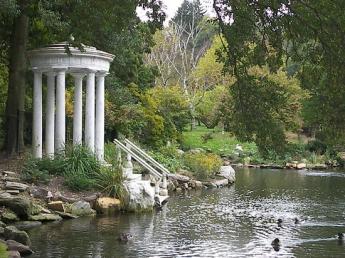 A new book has arrived, describing the 90 great public gardens of the Philadelphia regions, and discussing the best 40 of them in detail.
A new book has arrived, describing the 90 great public gardens of the Philadelphia regions, and discussing the best 40 of them in detail.
Quaker Gray Turns Quaker Green
 Quakers mean to turn their headquarters near Philadelphia City Hall into a glowing example of how to save money while they save their environment.
Quakers mean to turn their headquarters near Philadelphia City Hall into a glowing example of how to save money while they save their environment.
Delaware Bay Before the White Man Came
 This was the last major place on the East Coast to be settled because it was a swampy snaggy pond, full of fish and birds. And soon, pirates.
This was the last major place on the East Coast to be settled because it was a swampy snaggy pond, full of fish and birds. And soon, pirates.
Gardening
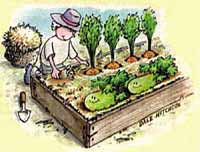 Gardening is making a comeback. Retirees are right in there.
Gardening is making a comeback. Retirees are right in there.
Gardens for Posterity
 New flowers can be planted each year, but forests take generations to grow. What you plant depends on who is meant to look at the result.
New flowers can be planted each year, but forests take generations to grow. What you plant depends on who is meant to look at the result.
Haddonfield Blooming Outdoors, Year-Round

Harriton House
 The original house in the old Welsh barony gave its name to Bryn Mawr, and once was the home of the secretary of the Continental Congress.
The original house in the old Welsh barony gave its name to Bryn Mawr, and once was the home of the secretary of the Continental Congress.
Highway Beautification
When American tourists notice this, they are very smug.
Laurel Hill
 Public attitudes about cemeteries continue to evolve.
Public attitudes about cemeteries continue to evolve.
Morris Arboretum
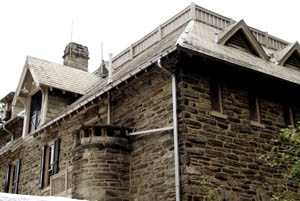 At the furthermost corner of Fairmount Park, the former estate of John and Lydia Morris is run as a public arboretum, one of the two or three finest in North America.
At the furthermost corner of Fairmount Park, the former estate of John and Lydia Morris is run as a public arboretum, one of the two or three finest in North America.
Native Habitat
 Increased foreign trade, especially to Asia, has brought us some new plant types. Lacking natural enemies, they are taking over.
Increased foreign trade, especially to Asia, has brought us some new plant types. Lacking natural enemies, they are taking over.
Philadelphia Green
 Philadelphia outdoor beautification effort linked up with its traditional community spirit of volunteerism for a smashing success.
Philadelphia outdoor beautification effort linked up with its traditional community spirit of volunteerism for a smashing success.
Philadelphia Gardens
 Philadelphia loves its gardens, particularly boxwood and azalea.
Philadelphia loves its gardens, particularly boxwood and azalea.
The Garden Show Evolves
 Exhibitors at the Philadelphia Garden Show have gradually evolved from amateurs to nurserymen, and from nurserymen to florists.
Exhibitors at the Philadelphia Garden Show have gradually evolved from amateurs to nurserymen, and from nurserymen to florists.
Greenhouses
 A greenhouse is a greenhouse, until you know something about them.
A greenhouse is a greenhouse, until you know something about them.
Litchfield's Past
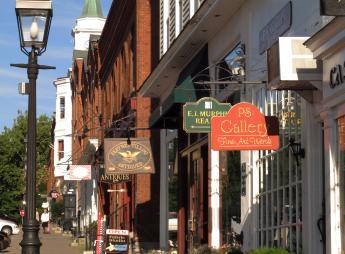 Litchfield, Connecticut is a charming little country town, a good place for successful New Yorkers to retire. But the name of the town means "a place where heretics are burned".
Litchfield, Connecticut is a charming little country town, a good place for successful New Yorkers to retire. But the name of the town means "a place where heretics are burned".
Green Roof at Peco
 That big black electric company building across from 30th Street Station has a green roof. That is, they have planted sedum on it, and it's attractive to visit. Economics is another matter.
That big black electric company building across from 30th Street Station has a green roof. That is, they have planted sedum on it, and it's attractive to visit. Economics is another matter.
Tyler Arboretum
 A 650-acre Arboretum next to a 2500-acre state park makes for a lot of nature walks and bird watching, as well as a gazillion azaleas and tree specimens. The only serpentine barren in Delaware County is located there.
A 650-acre Arboretum next to a 2500-acre state park makes for a lot of nature walks and bird watching, as well as a gazillion azaleas and tree specimens. The only serpentine barren in Delaware County is located there.
Ginseng Trading
 The Chinese love ginseng for its alleged aphrodisiac qualities, so it is not surprising that trade has flourished between China and Philadelphia. What's surprising is that ginseng flourishes in our exurbs, and is mostly exported to China, not from it.
The Chinese love ginseng for its alleged aphrodisiac qualities, so it is not surprising that trade has flourished between China and Philadelphia. What's surprising is that ginseng flourishes in our exurbs, and is mostly exported to China, not from it.
Weather Man
 The weather is a big business.
The weather is a big business.
American Chestnut Trees
 Scarcely a century ago, American Chestnut trees were a quarter of all trees in America. Now, they are almost all gone, but a thousand volunteers are trying to rescue them.
Scarcely a century ago, American Chestnut trees were a quarter of all trees in America. Now, they are almost all gone, but a thousand volunteers are trying to rescue them.
Enforcing the Constitution: Civil Monetary Penalties (CMP)
 The Constitution does not define penalties if one branch of government oversteps its grant of authority. But starting with writs of mandamus , the U.S. Supreme Court has left the other two branches with little alternative but compliance.
The Constitution does not define penalties if one branch of government oversteps its grant of authority. But starting with writs of mandamus , the U.S. Supreme Court has left the other two branches with little alternative but compliance.
Barnes Arboretum
 The Barnes impressionistic art has moved to the Parkway in Philadelphia, where Dr. Barnes said he never wanted it to be, But the Arboretum remains on Latches Lane in Merion, just across City Line Avenue, next to where Episcopal Academy used to be, and now is occupied by St. Joseph's.
The Barnes impressionistic art has moved to the Parkway in Philadelphia, where Dr. Barnes said he never wanted it to be, But the Arboretum remains on Latches Lane in Merion, just across City Line Avenue, next to where Episcopal Academy used to be, and now is occupied by St. Joseph's.